PRE2023 3 Group8
| Name | ID | Department |
|---|---|---|
| Geert Boer | 1894803 | Biomedical Engineering |
| Roel Domensino | 1758896 | Automotive Technology |
| Daan Kuijpers | 1892800 | Biomedical Engineering |
| Louise Rietra | 1859269 | Industrial Engineering |
| Chris Smeets | 1845403 | Biomedical Engineering |
| Thijn van Veggel | 1732358 | Psychology & Technology |
Plan Week 1:
subject
- Apps that help motivate youth to exercise
objective
- Creating a healthier youth by having them exercise more
Who are the users?
- Youth (16-25)
- Motivate to go to the gym
What do they require?
- They need motivation to exercise
- Reward system
- Guidance for exercise
Approach, milestones, and deliverables
- Research motivational techniques (for exercising)
- Questionnaire about what motivations works for people
- Brainstorm about reward system and avatars
- Create an app layout
- Connect a fitness database
- Classification of goals
- Questionnaire at the end
Who will do what:
| Members: | Main Task(s): |
| Geert Boer | App development |
| Roel Domensino | App development, Motivation |
| Daan Kuijpers | App development |
| Louise Rietra | Motivation, questionaries |
| Chris Smeets | App development/design, physiology |
| Thijn van Veggel | App design, Motivation |
Content Week 2:
GUI of an App
Colors
It is best to not use more than three colors, it should be as simplistic as possible. Different colors generate specific human behavior. Social media apps usually use mostly bright and vibrant colors, while mind and body apps usually use more neutral colors. Here are some words with associated colors:
- Security and trust: Blue
- Speed: Red
- Cheapness: Orange and yellow
- High quality: Black (orange the least)
- High technology: Black, blue and gray
- Reliability: Blue
- Fun: Orange and yellow
You have to think about the impression that you want to give the users. If you want to give the expression it is an entertaining app, than use warm tones, but if you want to show it is a trade or e-commerce app, then use cooler tones like blue or a gray-scaled scheme, which is more reliable.
GUI
The primary goal of a GUI if to allow the user to concentrate on the task at hand. The GUI must therefore make the interface between the human and app smooth. Humans have limited memory, so it is better to group information using the Gestalt principle, which means humans have a short term memory span of around 7 items. A good GUI should present information that is contextual and consistent. It should avoid unnecessary detail and put as much information in as less words as possible to conserve screen space. It is better to utilize familiar data formats, if they exist. Furthermore, a GUI should use colors to group information. Graphical boundaries are very effective in grouping items. Other highlighting techniques are reverse video, brightness, underlining and flashing. The information should be presented in a sequence which the user needs it in. More important information should precede the lesser important information and general items should precede more specific items. Frequently used or needed information or commands should be in the most important location. If there is no order, use alphabetical order. A bad GUI prevents the user from concentrating on its task. When designing a GUI, keep the objective in mind and avoid needless complexity.
https://dl.acm.org/doi/pdf/10.1145/279044.279051
How to motivate users
Research motivation
List of decision points:
- Improvement narrative (character to improve or collect, items to be collected, room/area building, etc.)
- Multiplayer (cooperation, competition, both)
- Tone of messages (very uplifting messages, more heavy handed messages Duolingo style)
- Frequency of messages (very often, less often, after inactivity)
- Consistency rewards (streak, how often to maintain streak)
- Punishment or rewards
- Difficulty
Relevant conclusions from sources:
Reaching goals important
Induce identified regulation (make sure that the consumer sees exercising as a very valuable thing to do for them)
Obstacles: lack of time, energy, and willpower.
Males were motivated by intrinsic factors (strength, competition, and challenge) (p < .05) and females by extrinsic factors (ie, weight management and appearance)
Use (Randomly) an Intermittent Reward Timing (RIRT). This is the most powerful schedule for dopamine release and staying motivated. The casinos use it to take people’s money. It works 100% of the time. You can use RIRT to your advantage, to stay motivated in any pursuit. The key is to celebrate your wins, but do not celebrate every win.
In conclusion, team sport activities seem to be intrinsically motivating to the participants through positive social interaction and play. They are therefore more likely to result in exercise continuation than activities that rely primarily on extrinsic motivation such as the expectation of improved health and well-being.
A diary study of female students engaged in weight loss attempts showed that, of participants who self-reported being furthest from achieving their long-term goals, those who experienced positive emotions arising from weight-loss behaviour on one day expended greater goal-directed effort on the subsequent day than did those who experienced negative emotions
Health-promoting actions which are extrinsically motivated i.e., performed to attain tangible rewards or avoid punishments, comply with instructions, or otherwise satisfy external demands may be less likely to be repeated than actions pursued due to genuine personal interest (i.e., intrinsic motivation), at least when external support for action is removed (Ryan & Deci, 2000). Intervention developers must therefore promote behaviours in a way that encourages people to internalise the need and desire for change, thus engendering self-determined, rather than compliant, behaviour change (Deci & Ryan, 1985).
Planning is as important for helping people repeat a behaviour as it is for initiation. Coping planning may be particularly important for supporting continued repetition of behaviour. One study found that for physical activity, higher levels of coping planning led to a stronger intention behaviour association, although only for those who were physically active at the start of the study
These findings suggest that competition and cooperation both have positive aspects and that structuring recreational activities to include both can facilitate high levels of both intrinsic motivation and performance.
The theory we developed posits that people are motivated to use TMT because of convenience and flexibility, environmental control, progress tracking with positive reinforcement, and knowledgeable trainers. We have observed that users report feeling a higher sense of motivation to apps that incorporate all of these aspects in their training
In terms of habit formation, according to Chen et al. (Citation2017), social motivation and goal-setting are key factors for a sustained use of SFMAs. This is also dependent on the type of user. Besides, there is time-dependent variability. Many authors observe that performance feedback is more stable than social feedback, which decreases over time. Stragier et al. (Citation2016) confirm that self-tracking is the paramount reason for adopting a SFMA, but also that the social value from the device contributes to maintaining its use over time.
harabod et al. (Citation2013) identify three main aims behind self-quantification: monitoring oneself (i.e. concerning a risk or threshold), making behaviour regular (i.e. to form a habit or routine) and/or optimising performance. Research indicates that apart from the first of these, SFMAs have somewhat limited effects; the information and analysis they provide often remain trivial.
One of the vaunted advantages of digital technology is that it connects users. In SFMAs, this can translate to sharing information, providing encouragement or motivating performance through competition or emulation. Same-sex users of similar athletic levels have the most significant influence on each other, due to processes of social influence and behavioural contagion (Aral & Nicolaides, Citation2017). Indeed, most of the exchanges in SFMAs are between ‘similar’ people (Pharabod et al., Citation2013), who compare information such as levels of performance, commitment, progress, etc. This is not unlike how sports institutions establish a hierarchy of competitive levels. Interestingly, the less active/regular practitioners influence the more active to a higher degree than the opposite; the creation of a homogeneous group seems to increase the latter’s motivation through ‘realistic’ emulation and flattering comparisons that encourage the maintenance of their superiority
Research shows that a user’s motivation to use an SFMA depends on how successful it is in producing outcomes. If these are positive, there is pleasure, confidence and a sense of achievement; this can help to create good habits and lead to the continued use of the device (Lupton, Citation2017; Semerjian, Citation2017). Carter et al. (Citation2018) explain drop-outs by the mitigation of a device’s effects over time, suggesting a decrease in extrinsic psychological factors. Encouragement and emulation through comparison do not generate sufficiently sustainable motivation (Goodyear et al., Citation2019), so after a phase of novelty-related enthusiasm and excitement, weariness sets in (Fritz et al., Citation2014). Worse, disappointment or even a sense of shame or guilt develops if the results are poor and the objectives are not achieved (Goodyear et al., Citation2019).
A source of early rejection may be that a device is not consistent with the user’s self-image: ‘it’s for the elderly’; ‘it’s for sports addicts’ (Lazar et al., Citation2015). The device may be excessively visible or have problems in terms of comfort or ergonomics. Some report other issues that lead to frustration:
- in terms of functioning: reduced interoperability or compatibility, time and effort required to load or sync data, impossible to use due to lack of connection (Canhoto & Arp, Citation2017)
- in terms of data: inaccuracy of measurements, unhelpful data, difficulty in understanding data (especially for novices) (Chen et al., Citation2017)
- in terms of transparency: the possibility of cheating and artificially increasing performance distorts comparisons (Goodyear et al., Citation2019).
When there is a feeling that a device requires ‘work’, the pleasure related to physical activity decreases. Etkin (Citation2016) argues that the expected enhancement of a workout is often coupled with diminished pleasure when self-tracking, due to both a decrease in intrinsic motivation and an excessive focus on results. A study on connected cyclists (Lupton et al., in press) shows that while the motivation and rewards obtained through SFMAs are appreciated, the data collection and analysis necessitates attention on a daily basis (e.g. preparation, charging, start-up and regular verification of the device). After a training session, interpreting the data (checking its accuracy, contextualising it and analysing it) is also time consuming, and somewhat distracts from the pure leisure of the practice. For these former users, unsubscribing from the app frees them from a burden that spoils their enjoyment of a sport meant to be recreational.
Literature to date on the topic of SFMAs demonstrates that some users find real support in setting goals, planning their sessions, and/or making physical activity a regular routine. These effects are in line with the promises of the device developers, and they should not be underestimated. The main innovation of SFMAs is their ability to uniquely combine features likely to generate motivation: belonging to a community, quantifying and keeping a record of one’s activity, analysing and comparing data, and discovering new practice routes.
The results indicate that the implicit, unconscious need to achieve facilitates regular engagement in sport activities, but the explicit, conscious orientation toward achievement does not. The enrichment of sports environments with incentives for the implicit achievement motive may thus attract more people to participate in sport activities.
Despite large potential and abundant usage by young people, limited research is available on apps and health promotion for adolescents. Apps seem to be a promising health promotion strategy as a monitoring tool. Apps can enable users to set targets, enhance self‐monitoring, and increase awareness. Three apps incorporated social features, making them “social media,” but hardly any evidence appeared available about their potential.
The wide variety of apps included in this 2018 study and the limited number of behavior change techniques found in many apps suggest an opportunity for improvement in app design that will promote sustained and significant lifestyle behavior change and, therefore, better health.
The results indicate that all four hypotheses were supported. Consistent with our hypothesis, facilitating conditions positively affect fitness app user’s physical activity behavior. Further, user’s attitude has a significant positive effect on their actual physical activity behavior. Thus, H3 and H4 were supported. As for the moderating effects, perceived competitive climate was found to positively moderate the relationship between social comparison and user’s attitude, which is consistent with H1. On the other hand, self-efficacy about physical activity negatively moderates the relationship between social comparison and attitude, which is consistent with H2.
-Making the app “social” is more effective than making it “fun” in helping consumers sustain their efforts in physical activity.
-Consumers using the app focusing on social value showed better performance in walking and higher intentions to continue using the app.
Gamification was used by 64% of mobile applications. Most applications that included gamification (97%) targeted behaviors related to physical activity and weight loss. Applications focused on other areas such as reproductive health, meditation, and sleep used gamification less often (11%). Game elements used most commonly included goal setting (78%), social influences (78%), and challenges (63%), while less common elements included points (6%) and levels (3%). No applications incorporated behavioral economics principles specified in the study.
Gamification was commonly used by popular health and fitness mobile applications, but none used the specified behavioral economic principles to design rewards or points. Mobile applications could potentially improve their use if their design better leveraged principles from behavioral economics.
Link: Effectiveness of Loyalty Programs in Customer Retention: A Multiple Mediation Analysis - Andy Chin Woon Fook, Omkar Dastane, 2021 (sagepub.com)
Findings show that there is a significant positive impact of loyalty programs on customer retention.
Link: Effects of Perceived Agency and Message Tone in Responding to a Virtual Personal Trainer | Proceedings of the 18th International Conference on Intelligent Virtual Agents (acm.org)
Like in-person coaches, the live human trainer who used negatively valenced messages were well-regarded; however, when the agent or avatar used negatively valenced messages, participants responded more poorly than when they used positively valenced ones. Perceived agency also affected rapport: compared to the agent, users felt more rapport with the live human trainer or the avatar. Regardless of trainer type, they also felt more rapport - and said they put in more effort - with trainers that used positively valenced messages than those that used negatively valenced ones. However, in reality, they put in more physical effort (as measured by heart rate) when trainers employed the more negatively valenced affective tone.
Links:
A word of advice: how to tailor motivational text messages based on behavior change theory to personality and gender | Personal and Ubiquitous Computing (springer.com)
Daily Motivational Text Messages to Promote Physical Activity in University Students: Results From a Microrandomized Trial | Annals of Behavioral Medicine | Oxford Academic (oup.com)
Full article: The role of questionnaire length and reminders frequency on response rates to a web-based epidemiologic study: a randomised trial (tandfonline.com)
Full article: Towards understanding the mechanism through which reward and punishment motivate or demotivate behaviours (tandfonline.com)
- So far, research has argued both in favour and against using Reward and Punishment strategies in behaviour change applications due to mixed results with respect to their effectiveness. It was unclear how interventions using these strategies could motivate or demotivate behaviours. With this paper, we elucidate the strengths and weaknesses of Reward and Punishment strategies by showing that both can have positive (e.g. increase the level of commitment, enjoyment, and engagement, helping users achieve their goals) and negative (e.g. experience frustrations, depression and can promote cheating) influences on people’s behaviour and perception of persuasive gamified systems.
- We compared the perceived effectiveness of Reward and Punishment quantitatively and found that Reward strategies can engage users and make behaviour fun, reinforce commitments to goals, reveal some consequences of bad behaviour, and their tendency to redirect behaviour intention and trivialise the consequences of bad behaviour. In contrast, Punishment strategies can be depressing, discouraging, and demoralising; therefore, elements of Punishment must be strategically implemented in the persuasive gamified systems, especially those targeted at health behaviours.
- We offered practical design recommendations for implementing the Reward and Punishment strategies in persuasive gamified systems to increase their effectiveness. These include recommendations such as implementing mechanisms to prevent cheating, consider using dynamic reward and multiple implementations for the same persuasive strategy, as well as offer a variety of reinforcement strategies and adaptation mechanisms to attract new users while sustaining existing users.
lLink: Studying Gamification: The Effect of Rewards and Incentives on Motivation | SpringerLink
Motivation is demonstrated by an individual’s choice to engage in an activity and the intensity of effort or persistence in that activity (Garris et al., 2002). Current approaches concern two dominant clusters that play a role in determining player’s motivation: extrinsic and intrinsic motivation (Deci, Koestner, & Ryan, 1999; Ryan & Deci, 2000a). Gamification combines these two motivations; on one hand using extrinsic rewards such as levels, points, badges to improve engagement while striving to raise feelings of achieving mastery, autonomy, sense of belonging (Muntean, 2011).
2.4.2 Need Achievement Theory
Achievement behavior is directed at developing or demonstrating, to self or to others, high rather than low ability (Atkinson & Litwin, 1960; Nicholls, 1984). It implies that in achievement situations people desire success to the extent that it indicates high ability and seek to avoid failure which may be a signal of low ability (Nicholls, 1984). According to Atkinson, to achieve success and to avoid failure are two separate motives. These two motives affect the level of task difficulty people choose to undertake. People with high motivation to succeed prefer tasks of intermediate difficulty (Atkinson & Litwin, 1960). However, if the motive to avoid failure is stronger people prefer either very simple or very difficult tasks (Atkinson & Litwin, 1960).
Goal setting theory claims that difficult, specific, context-appropriate, and immediate goals, rather than long-term goals, motivate to achieve more (Ling et al., 2005). Goals affect performance by directing attention, assembling effort, increasing persistence and belief in ability to complete a task (Locke et al., 1981). Goal setting is most likely to improve task performance when the goals are specific and sufficiently challenging, the subjects have sufficient ability, feedback is provided to show progress in relation to the goal, rewards are given for goal attainment, and the assigned goals are actually accepted by the individual (Locke et al., 1981).
Kraiger et al. (1993) assert that self-efficacy can be positively stimulated by dividing tasks of higher difficulty into smaller, less difficult tasks. They state that the more people believe they are able to bring a certain task to a successful ending the better they will perform at this task (Kraiger, Ford, & Salas, 1993).
According to the theory we evaluate our beliefs, abilities, and reactions by comparing them with those of others (Gilbert, Giesler, & Morris, 1995; Lillienfeld et al., 2009). Festinger’s “similarity hypothesis” predicts that people compare themselves with similar others (Festinger, 1954; Gilbert et al., 1995). The “unidirectional drive upward” asserts people wish to continually improve their abilities. Altogether people strive toward a better position than that of others they compare to (Wood, 1989).
Motivational implementations
Concise-choices made-substantiation
Possible implementations:
-Progression system
-Multiplayer
-Motivational messages/reminders
-Consistency system
-Exercise schedule
For each of these implementations, choices must be made on how to introduce them to the app or not at all. In this section each possible implementation is explained, and motivation is given on how to include it in the game, or why it was not included.
Progression system
As the name suggests, the progression system is a system where users are rewarded for exercising in the form of progression in a certain system. This can range from simply gaining points or leveling up to collecting fictional characters. This system encourages users through extrinsic motivation with rewards, to improve engagement, while also raising feelings of achieving mastery, autonomy, sense of belonging as intrinsic motivation [1].
The most important decisions to be made are what kind of progression system is to be used, how difficult should this system be, how often should rewards be given and should punishments be used as well?
As there isn’t a clear best progression system, we decided that it would be most optimal to investigate what the consumer would prefer through a survey and decide based on that.
“People with high motivation to succeed prefer tasks of intermediate difficulty. However, if the motive to avoid failure is stronger people prefer either very simple or very difficult tasks” [1]. As our app is used to succeed in exercising regularly, most users should possess a motivation to succeed instead of a motivation to not fail. As such we will implement tasks of intermediate difficulty based on users' previous data.
“Use (Randomly) an Intermittent Reward Timing (RIRT). This is the most powerful schedule for dopamine release and staying motivated. The casinos use it to take people’s money. It works 100% of the time. You can use RIRT to your advantage, to stay motivated in any pursuit. The key is to celebrate your wins, but do not celebrate every win”[2]. Sources suggest that the most efficient way of handing out rewards is by making the random and unpredictable. To implement this, a random chance for a bonus multiplier on normal exercise rewards could be given. It could be considered to make this random bonus influenced by how much a user has been exercising, so that extra effort is rewarded. This could be further discussed in the future. The normal exercise rewards are handed out when a user completes a set of exercises, specifically when they complete a full schedule. Additionally extra rewards could be handed out for consistency, but this will be discussed in the section for consistency rewards. These rewards are always handed out instead of using RIRT as these are the cornerstone of the progression system.
“We compared the perceived effectiveness of Reward and Punishment quantitatively and found that Reward strategies can engage users and make behaviour fun, reinforce commitments to goals, reveal some consequences of bad behaviour, and their tendency to redirect behaviour intention and trivialise the consequences of bad behaviour. In contrast, Punishment strategies can be depressing, discouraging, and demoralising; therefore, elements of Punishment must be strategically implemented in the persuasive gamified systems, especially those targeted at health behaviours”[3]. Given this risk of using punishments when targeting health behaviors, we decided that it would be better to not implement them as the risk of using them is not worth the possible positive effect they could have, especially since we don’t have a lot of experience on how to strategically implement them.
Multiplayer
This implementation is all about using cooperation and/or competition to inspire more motivation in the users. This can be done through teams, rankings, challenges between individuals, challenges between teams, communal goals and the like. According to sources the combination of cooperation and competition is most effective at motivation [4]. To ensure more certainty, we have decided to inquire about this in the survey to ensure the correct choice is made. Based on the results a decision will be made in the future.
Motivational messages/reminders
According to [5], personality and sex of a user are relevant for the effectiveness of messages with a certain tone. Generally, the most effective tone is positive and cooperative. Given the difference per user, we decided to obtain opinions from the users by including it in the survey and by allowing a user to choose between a few different tones which were preferred the most according to the survey. The positive and cooperative tone will most likely be used as the default of the options.
Consistency system
A consistency system is a way of rewarding users for consistently doing something. Examples of this are streaks in snapchat, daily logins for a week but also for example car insurance, where the longer you do not claim something the less you have to pay. According to [6], these systems are relatively effective at creating habits and as such are certainly something we would want to implement. In our case such a system will work weekly, where the user will get a progressively increasing multiplier to rewards, they get from doing exercises. In is not daily since many cannot exercise every day and it is not longer than weekly since exercise should be done regularly [7].
Exercise schedule
Our app could assist users by giving them an exercise schedule to refer to while in the gym to ensure that they perform a well-rounded routine fitting to their goal. Whether such a schedule should be static or flexible will be determined from the survey results. Examples of a flexible schedule would be suggestions through which the user can construct a schedule themselves or a given schedule could be adapted by allowing users to veto an exercise and receive a different one of the same type. Also, the reason for each user going to the gym is used to steer the exercise schedule creation.
Sources:
[1] Studying Gamification: The Effect of Rewards and Incentives on Motivation | SpringerLink
[2] Tools to Manage Dopamine and Improve Motivation & Drive - Huberman Lab
[3] Towards understanding the mechanism through which reward and punishment motivate or demotivate behav (tandfonline.com)
[4] The Effects of Cooperation and Competition on Intrinsic Motivation and Performance. (apa.org)
[5] A word of advice: how to tailor motivational text messages based on behavior change theory to personality and gender | Personal and Ubiquitous Computing (springer.com)
[6] Effectiveness of Loyalty Programs in Customer Retention: A Multiple Mediation Analysis - Andy Chin Woon Fook, Omkar Dastane, 2021 (sagepub.com)
[7] Regular physical exercise: way to healthy life. - Abstract - Europe PMC
Motivation: When exploring students’ motivation, the majority were extrinsically motivated. Only three students reported exercising for the inherent pleasure or satisfaction of it (intrinsic motivation). When asked why he chose to exercise one student replied, “I just like it, I don’t really care about the weight part I just like exercise.” A majority of students (79%, n = 19) were found to be motivated via identified regulation. Students chose to engage in activities because they deemed them valuable and a necessary component of achieving an external goal such as weight loss or improved health. As one student responded, “Um just to stay healthy, don’t get overweight, you know, I don’t know, just feel good about myself.” Another student explained, Well couple of things, first of all it’s good for you. So my Grandma, died of a heart attack and I wasn’t sure if like it was because she was a little heavier than she should be for her height. So that was just one thing like in order to have a good heart you need to eat healthy and exercise which is stuff she didn’t do, and then another reason is I’m trying to lose weight in like my stomach and legs so I figured exercising is good
Results: The most commonly reported motives for exercise were, to gain strength and endurance (M = 4.50, SD =.14), to have positive health (M = 4.46, SD =.15), and weight management (M = 4.09, SD =.18)
Discussion: Regarding exercise motivation, the survey and interview results concur, college students meeting ACSM exercise recommendations were most commonly motivated via identified regulation, the second most autonomous form of extrinsic motivation. This indicates students were motivated by a self-determining behavior (e.g., improved looks, weight loss, health). Previous literature has found identified regulation to be a key indicator of initiation and short-term exercise adherence (Markland, 1999). These findings did not differ based on size or gender. This is contrary to another research study that found females were more likely to participate in campus recreation services due to less self-determined extrinsic motivators (Cooper et al., 2012). Interestingly, one of the top extrinsic motives for exercise regardless of weight or gender was a desire to improve strength and endurance. This differs from previous findings that have found strength and endurance to be a more common motive among males but not females (Kilpatrick et al., 2005)
Conclusion: This study found college students meeting ACSM exercise recommendations were primarily motivated by external factors (e.g., to look good) rather than inherent intrinsic factors (e.g., enjoyment). In addition, the study determined the type of motivation does not differ by BMI or gender. The results of this study suggest college students who are meeting ACSM exercise recommendations chose to engage in exercise primarily due to external reasons. These reasons do not vary based on gender or size and therefore should be considered an effective approach for targeting a broad scope of college students. Future interventions should be targeted within campus recreation programs and focus on developing innovative solutions for helping students maintain their exercise regimen as well as strategies to enhance to social support and competence to engage in a variety of modes of exercise.
Link: https://journals.sagepub.com/doi/abs/10.1123/rsj.2017-0026
The most important take away from this article is:
This suggests that the way difficulty is measured is important for our understanding of motivation.
Link: https://link.springer.com/article/10.1007/s11218-011-9157-z
State-of-the-art
https://www.youtube.com/watch?v=irMJLcmSG5k
This is a youtube video of the 10 best fitness apps for 2023. It gives an explanation of what you can get out of each app
Nike training club – Free
- It differentiates based on different muscle groups. Each exercise showcases a short video of how the exercise is done.
- There are also follow along workouts in which you train with a personal trainer.
Adidas training – Free, but there is a premium version
- It also has video clips of the the exercises.
- There are also follow along workouts in which you train with a personal trainer.
- You can filter exercises based on focus, difficulty, time, etc. This way it is very easy for you to personalize a training program.
Home workout – paid
- It is body goal-oriented. It will tell you how long it takes you to finish your goal
- Daily tracker, in which you can see all the movements you have done that day and you can log the amount of calories you have eaten and the amount of water you drank.
Muscle booster – paid
- You are given a plan to follow based on your goals.
- It gives a video demonstration of the exercise.
- There is no audio support
- There is a workout and exercise database, where all of the exercises are stored based on the muscle group.
- There is also a whole section on meal plans. That offers various recipes based on your diet.
Peloton – Paid
- You have access to many different trainers that guide you to your goals.
- You can filter based on class type and the trainer will guide you throughout the whole workout.
- You have also access to live classes
- You do not have to own a peloton device, you can also do yoga for example or strength training.
Apple fitness plus
- You can follow along workouts given by a personal trainer.
- There is a variety of things you can do like running, gym, etc.
- However, you need to own an apple watch.
- You also have a walk with me feature, where you listen to famous people talking to you about things.
Fitbod – Paid
- This app is mostly based on strength training.
- It has a feature in which you can filter what equipment you have available (The most extensive list)
- Each exercise is not only followed by a video of the exercise, but it is also explained in great detail, and you can see exactly what muscle groups the exercise targets.
Aaptiv – Paid
- This is an app that is audio based.
- You have access to a wide range of exercises in many different categories.
- You can filter based on equipment available, body parts, etc.
- Some exercises do not have a video of how it is done, but others will have it. What is important is that all of the exercises are also audio-recorded. So, even if you do not see the exercise you are still guided through it.
FitOn – Free but with premium
- During all the workouts, you train with a personal trainer.
- If you do not want to listen to the trainer, you can upgrade to premium and listen to songs.
- Premium includes: music, meal plans, connects wearable devices(fitbit).
Centr – Paid
- There are many different styles of workouts to choose from
- There are follow along guided workout videos and some guided exercises.
- You have the ability to filter based on time and equipment.
- There is also a whole section on meals
https://www.ncbi.nlm.nih.gov/pmc/articles/PMC7510592/
As a diverse field of research that is related to an emerging phenomenon, and with the integration of new technologies, the research available on fitness apps is still scarce. Both empirical research and theoretical orientation reviews, mostly focus on summarizing the functions and features of fitness apps and user perspectives. As a result, there appears to be a lack of more macro and objective quantitative research in this field. And the various types of literature are not as substantial or abundant compared to other mature areas of research.
Well, why would we want a new fitness app? The high rate of obesity is one of the most worrying factors for health globally according to the article. Even nowadays it is perceived that children have a high risk of obesity. That is why a healthy lifestyle is recommended for all age groups. This can be done by following a balanced diet and exercise. Using a mobile fitness app is a modern way to ensure that people reach their fitness goals. However, clinicians still lack confidence in the protocols provided by these applications, but due to the wide availability of users. Mobile fitness apps can become very effective and boost healthy habits at a low cost.
Most of the research done in this topic is conducted through experiments and the country that contributes the most to this area is the United States.
Based on the generalization of all the information obtained and the review of the abstract and some of the full text, we found that the performance and function of fitness apps, the benefits for chronic disease treatment, the influence of using fitness app for public health, and factors of motivations of using fitness apps are currently popular research topics in this field. Future research could build on these directions and incorporate relevant issues from a social science perspective (e.g., consumer motivations, consumer engagement, consumer behavior, etc.) to further investigate on fitness applications.
https://www.makeuseof.com/apps-gamify-fitness-routine/
This link shows 5 fitness apps that use a gamified function in their app.
PlayFitt
• In-game avatars that move, grow and celebrate right along with you
• Build your movement social circle to nudge, gift and stay motivated with friends
• The easiest way to make 21 minutes of daily exercise a habit—the clinically proven amount of exercise you need every day to live a longer, happier, healthy life
• Compete for top spot on league leaderboards and beat your buddies on friends leaderboards
• Hassle-free and hands-free automatic rep counting for dance, steps, stairs, squats, push-ups and more
• Streaks and streak rewards to keep you motivated longer
• Movement goals that automatically adapt to your progress and form lasting habits
• Simple and fun exercise games that reverse the harmful effects of sitting all day
• Full Apple Watch and HealthKit integration
Hops – journey of tree spirit
- Explore the beautiful forests with cute Hops
- Get traveling energy by achieving daily goals
- Get crafting materials from your steps
- Change outfits and get cool effects
- Collect Friends by completing missions
- Glanceable recent activities and stats
- Measure Walking workouts
Treeceps
1.) Get strong and build muscle with highly effective workouts
• Train at home or in the gym by choosing your equipment
• No experience required: Treeceps will teach you how to perform real, effective strength training, rep by rep
• If you’re new to strength training: Let the artificial intelligence create the perfect plan, based on your time, equipment and goals
• For experienced lifters: Create your own routine and track it in the world of Treeceps
• High quality 3D animations (female + male) show exactly how exercises should be performed
• Receive science based tips for your training by Dr. Fox
• Easy to use workout tracker that guides you through your training in a way like no other app does
• Advanced features such as 3D muscle utilization visualization, detailed workload and fatigue estimation per muscle group, RPE tracking, progress statistics, progression suggestions and much more
2.) Be active and get lean by increasing your daily activity
• Your steps in the real world produce grass and feed Runimals
• Grow flowers and unlock Runimals through fitness achievements
• Climb flights of stairs and grow your lighthouse
• An immersive world, influenced by your activity, with simulated daytime and weather effects
• Receive humorous weather forecasts to find out the perfect moment to go for a walk
• Be prepared for many surprises along the way Treeceps is available exclusively for Apple devices, build from the ground up with latest Apple technologies.
• Metal based rendering provides an immersive world with simulated daytime, weather, incredible lighting effects and detailed exercise animations
• iCloud sync allows you to collect steps and stairs on your iOS devices or Apple Watch during the day and admire your progress on your Mac at home
• Game Center leader boards let you compete against your friends with your own fitness achievements
• Support for the latest macOS features such as automatic Dark Mode, You are Not able to create your own exercises.
Nerd Fitness journey
The Journey is a self guided choose your own adventure experience where you build habits at the pace the app sets for you. It has different nutrition, mindset, and fitness goals to choose from, which include bite-sized story elements along the way as you complete missions, build your superhero persona, tackle boss battles, and build real-life healthy habits.
Fitness RPG
KEY FEATURES:
* Fitness RPG - Convert your steps into free energy and use them to level up heroes
* Sync steps - Uses steps from your phone or sync steps from your Fitbit
* Battlegrounds - Explore the Fitland map, fight monsters and save the kingdom
* Team of heroes - Collect and train different heroes, form your ace team
* Precious equipment and skins - Collect, upgrade precious weapons to make your team stronger
* Arena - Compete with other players and fight your way to the top
Maybe look into how obesity is linked to students and if we can find a source that says that students with obesity or not per se obesity, but just lazy people are more likely to sit inside and play video games we can say that creating an application that incorporates both movement and gaming can help motivate this category.
https://shakuro.com/blog/fitness-app-gamification-in-2021-a-trend-you-cant-miss
Most of the users are tired of classic fitness coach app ideas and looking for something that will motivate them more. Games are one of the basic forms to engage people in various activities since childhood.
Doing some research into the reviews of the apps mentioned above, it is perceived that some of the apps still have bugs in them that some users point out. Also, doing some research I can see that the apps mentioned above do not really have the features that we are trying to add. Some apps only do tracking, others also have workout plans and videos that help with performing the exercise. Furthermore, there are apps that have built a whole world in which you can navigate. However, have not found an app that really gives you the opportunity to change your avatar according to how far you have come in your fitness journey. Some apps do offer customization options like changing clothes. However, I have not come across an app that will let you grow muscles and that also works.
Also, a lot of the apps have avatars that do not look like humans. So, that is also different from our idea.
The initial results also show a noteworthy adoption of gamification in specific mobile fitness apps, where a considerable number of smartphone users exploit the gamification mechanics applied (Souza-Júnior et al., 2016). In specific, walking, running and weight loss apps top the list, thus, more research studies should be undertaken and even more customized m-services need be developed focusing on these activities with the aim to satisfy every single m-health app user as much as possible. Concerning gamification mechanics, challenges followed by achievement badges, competition and scoreboards seem to lure much more users to utilize these apps. According to the literature review, gamification can strengthen individuals’ internal motives with the aim to change and improve their health behavior. Therefore, it goes without saying that gamification is expected to be incorporated even more on mobile fitness apps in the near future. Especially developers who take advantage of the behavioral theories that link psychological impact with gamification mechanics are expected to have even more prosperous prospects.
https://link.springer.com/chapter/10.1007/978-3-031-24294-6_24
State of the art study:
In order to improve on the already existing apps it is important to understand the applications that are currently available. The goal of our app is to motivate people to exercise more. This can be done by applying behavior change theory on a fitness app. One very popular way to keep users engaged is to gamify the app. This will generally improve the interaction between the user and the app. However according to a study in 2016 only 4% of fitness apps applied any use of gamification (Edwards et al., 2016).
´Behaviour change categories used were: feedback and monitoring (n=60, 94% of apps), reward and threat (n=52, 81%), and goals and planning (n=52, 81%). Individual techniques were: self-monitoring of behaviour (n=55, 86%), non-specific reward (n=49, 82%), social support unspecified (n=48, 75%), non-specific incentive (n=49, 82%) and focus on past success (n=47, 73%). Median number of techniques per app was 14 (range: 5–22). Common combinations were: goal setting, self-monitoring, non-specific reward and non-specific incentive (n=35, 55%); goal setting, self-monitoring and focus on past success (n=33, 52%).’ (Edwards et al., 2016)
This can then be further divided into the specific gamification aspects used by these apps as seen above.
Another more recent study in 2019 analyzed 212352 health and fitness apps of these apps it was found that about 5018 could be considered gamified. However a mere 344 were truly classified as behavior change apps. This is a shocking 0.16% of all ‘health’ apps. This study didn’t just look at fitness/exercise apps but also at apps to help stop smoking or to eat healthier. The 344 behavior change apps were then further analyzed to check their effectiveness. Two scales were used on the first scale the apps scored an average of 2.93 out of 5. And on a one point per criteria scale the highest scored was 17 out of 21 with an average of 7.8 . This indicates that even though a lot of fitness apps exist they severely lack a strong foundation of behavior change theory (McKay et al., 2019). Our app could set itself apart by including some true behavior change theory. With especially crucial things like social support being only used by 3% of all apps (Edwards et al., 2016). According to an older study this can be attributed to the fact that app developers come from a variety of backgrounds. They often lack the Theory to base their apps upon. So if we want to improve on these apps we should use behavior change theory to expand on the existing foundations of the apps that are currently available.
This literature research mostly provided knowledge on the lack of behavior change theory in fitness apps. Combining the knowledge of what the apps seems to lack now, what the users want the app to contain (through surveys) and what behavior change theory says should work could create a more stimulating fitness app.
McKay, F. H., Wright, A., Shill, J., Stephens, H., & Uccellini, M. (2019). Using Health and Well-Being Apps for Behavior Change: A Systematic search and Rating of apps. Jmir Mhealth and Uhealth, 7(7), e11926. https://doi.org/10.2196/119264
Edwards, E., Lumsden, J., Rivas, C., Steed, L., Edwards, L., Thiyagarajan, A., Sohanpal, R., Caton, H., Griffiths, C., Munafò, M. R., Taylor, S. J. C., & Walton, R. (2016). Gamification for health promotion: systematic review of behaviour change techniques in smartphone apps. BMJ Open, 6(10), e012447. https://doi.org/10.1136/bmjopen-2016-012447
Cowan, L., Van Wagenen, S. A., Brown, B. A., Hedin, R. J., Seino-Stephan, Y., Hall, P. C., & West, J. H. (2012). Apps of Steel: Are exercise apps providing consumers with realistic expectations? Health Education & Behavior, 40(2), 133–139. https://doi.org/10.1177/1090198112452126
Questionnaire 1 results
Link questionnaire: https://forms.gle/ZRBihpS5EVGqeqFLA
N = 113
Personal identification
39.8% female, 57.5% male, 2.7% other
Average age is 19.76, ranging from 17 to 24
94.7% is a Student
Current exercise situation
Average frequency of exercise is about 3 times a week (When considering “more than 5” as 6.5)
About 70%(69.9%) would like to exercise more
2/3 of all participants would like to do strength training, 44.1% would like to do Hypertrophy and 68,5% would like to do cardiovascular training.
61.9% is interested in using an app for exercise motivation
64.2% does not currently use a tracking/fitness app
App shape
Option 1(lightblue and gray) is the most popular (55.8%), others don’t get higher than 22.1%. Around 10% is displeased with all concepts.
Preferred tones are Funny (56.8%) and Considering (43.2%)
Multiplayer
Competing against other people is endorsed by 73.5%
Of those who want multiplayer:
94,4% would like to compete against friends
80,6% would like to compete against others
(note that the amount of people that replied varies, with n=90 and n=93 respectively, this is also not representative with the original 73.5%, showing that on average about 9 people answered against multiplayer, but still gave feedback on its creation)
Push notifications
About 70% (69.6%) would like to receive motivational push notifications
Only 38,4% would like to receive notifications about in game events or other-player progression.
Program creation
78,4% would like to make their own exercise program
88,4% would like to receive a program, based on their goals
On a scale from 1 to 5, the preferred customizability is 3.7 (2.7 if 0 to 4)
Tracking in between exercises is possible for 85.7%
On a scale from 1 to 5, the willingness to have predetermined exercise times is 2.25 (1.25 if 0 to 4)
The progression systems are ranked as follows;
- Character level up (53.2%)
- “wins” over other players (43.2%)
- Gaining currency/Exp (36.9%)
- Power levels (32.4%)
- Character gathering and leveling (29.7%)
The character creation systems are ranked as follows;
- Humans (57.7%)
- Animals(40.5%)
- Fantasy creatures(31.5%)
- Hybrids(15.3%)
Excel sheet with all the data should still be added to the Appendix
App development
To develop the app further, we looked at how other apps work and whether we could take inspiration for our app from this. We also worked on the app itself using the figma programme. Photos of our current progression of the app will be added below.
Progress week 1:
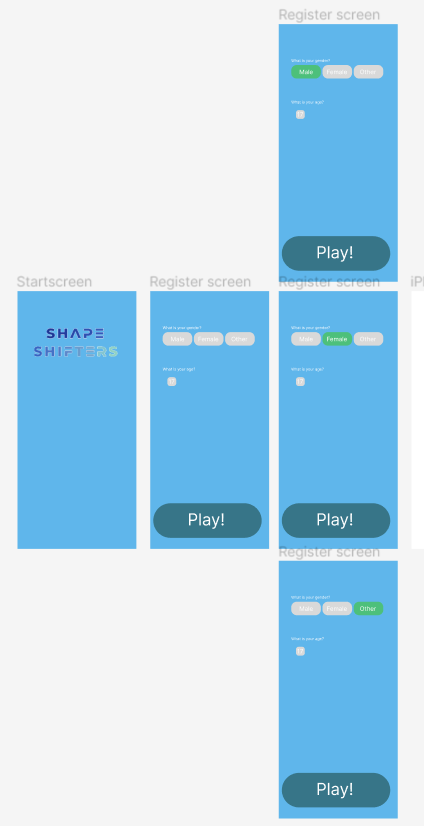

Week 2:

Content week 3
Every member was tasked to create some quick sketches of pages of the app at the start of the week. Over the weekend every member was assigned a specific type of page to make a more detailed design for.
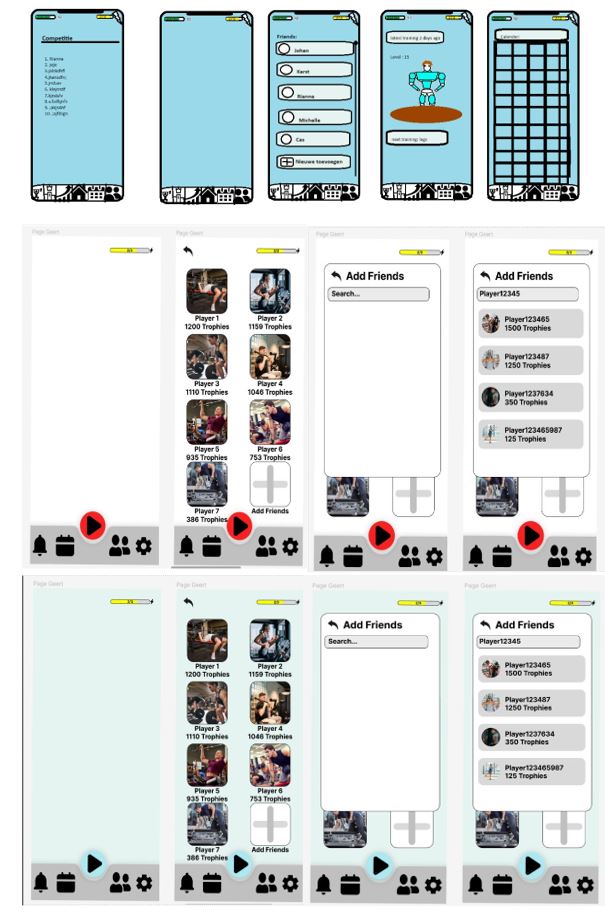
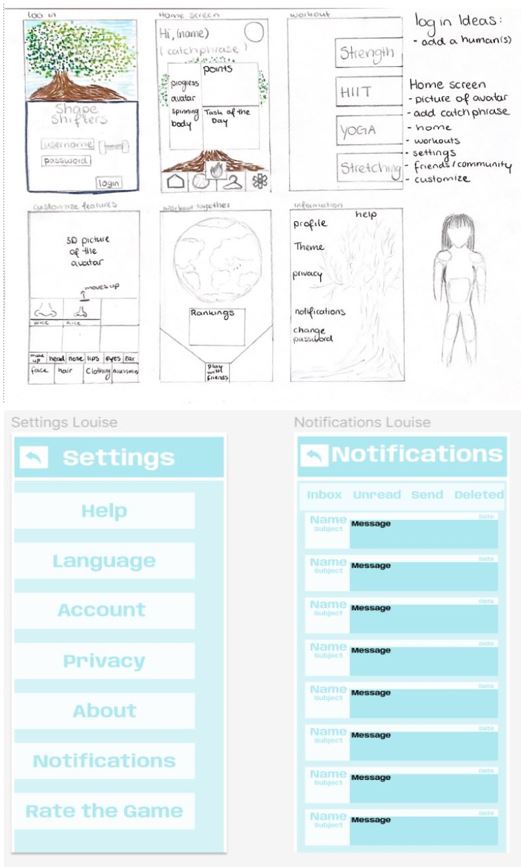
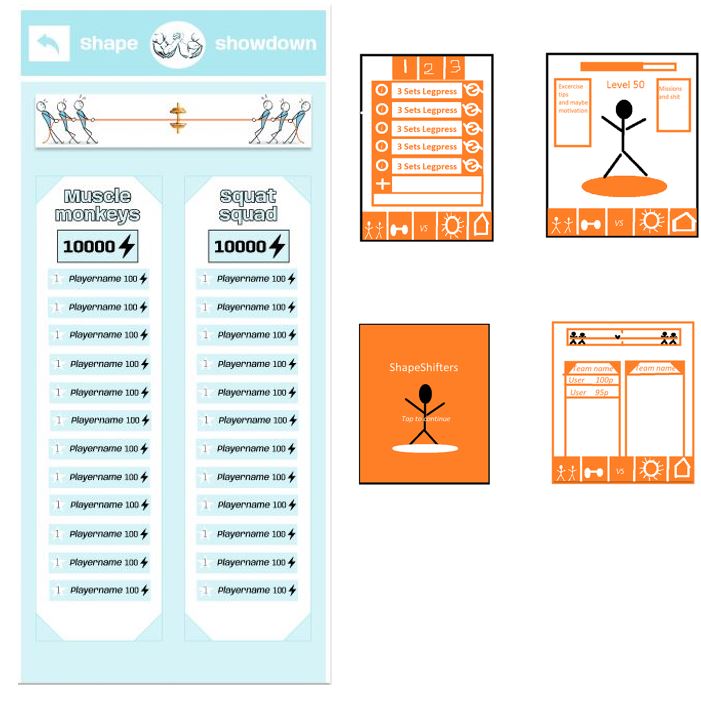

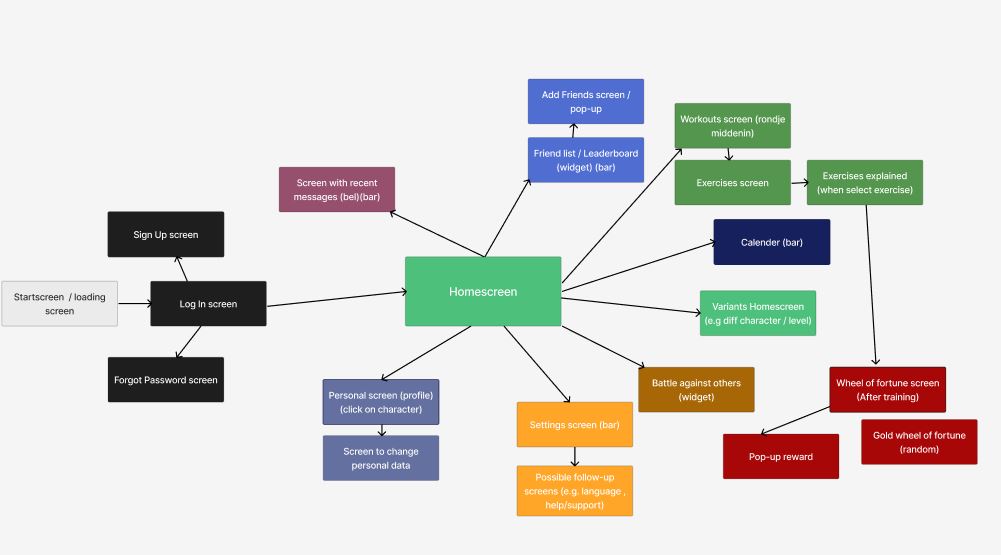
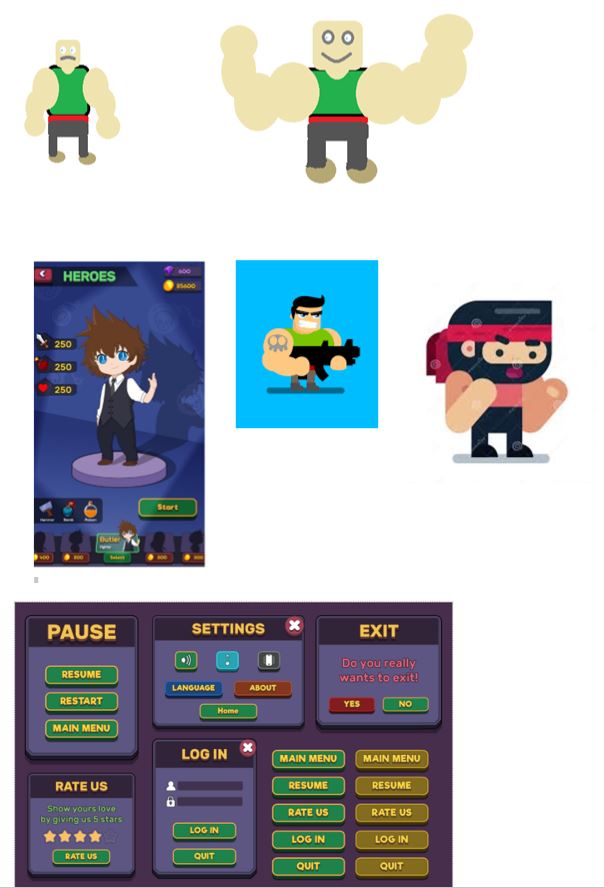

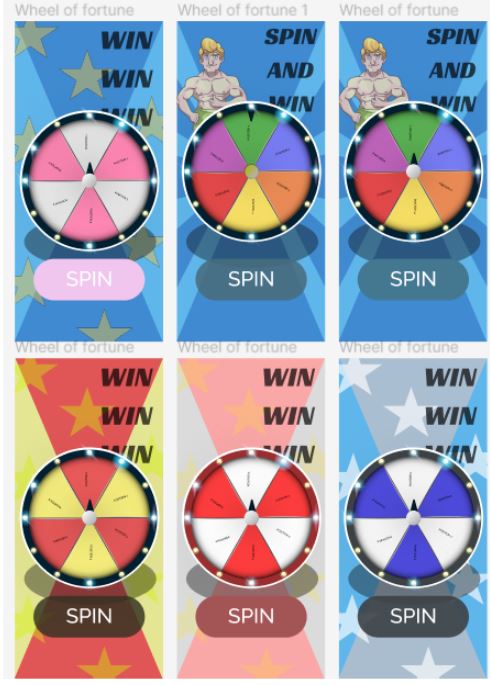
Beginning of a MOSCOW model
Must have:
- Level
- Character in home screen
- When you click on it you get to the profile
- Widgets to show
- Leaderboard
- Brand logo / app name
- Bar that makes you jump to: you have this in every screen except the workout screen there is a backwards arrow.
- Settings
- Workout
- Automatic log in if you have already been logged in before
Spinning wheel appears when the a workout is completed
You get an empty screen and you can add your own exercises or we provide a preprogrammed workout and you can change the exercise according to your preference.
The friendlist is in a list of leaderboard and it is monthly
Ideas for screens:
- During work-out screen: Screen where workout can be started (separate screen or on homescreen), character in sport positive / on t move
- Different leaderboards: Multiple leaderboards per muscle group / exercise
- Maybe make the login / sign up screens a bit more gamified (more colors)
Other ideas for app:
- In-game background music: Motivational music to keep the app a little more exciting (though option to turn off)
Win Game designs
Ideas prices:
SUPER WORKOUT: Next workout double XP 2x
NUTRITION BOOST: Character gains extra XP
BUDDY MOTIVATION: Gain extra XP when going with a friend
GOLDEN SPIN: Spin the golden wheel
STREAK RECOVERY: Gain a streak recovery, usable when streak is gone
REST DAY: Character gains extra XP for taking a resting day
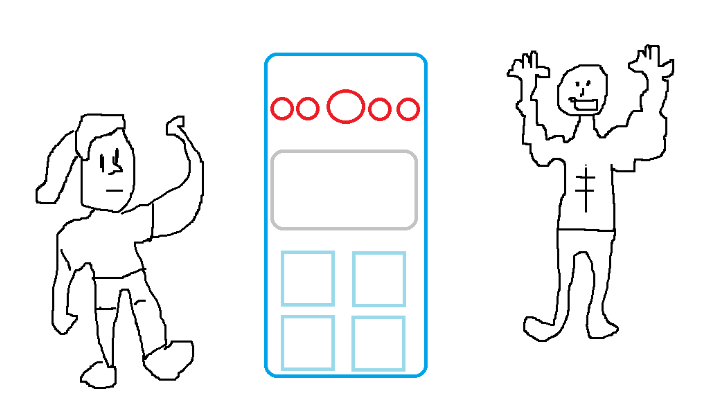
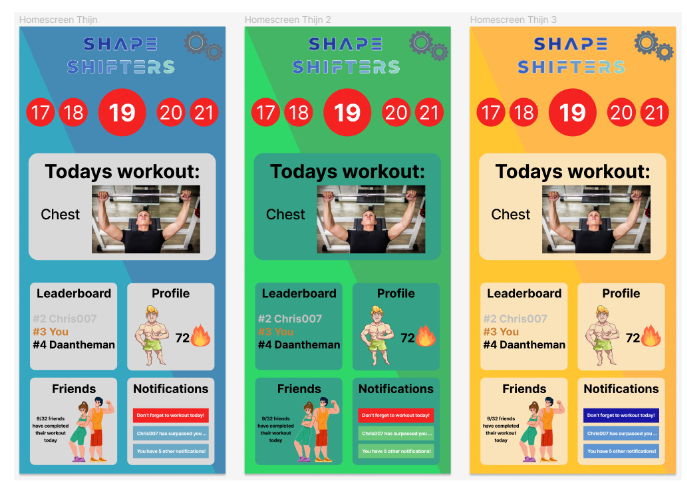
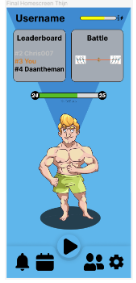
Content week 4:
Fifty healthy participants were randomly assigned to a video game training (TG) or control group (CG). Before and after training/control period, functional magnetic resonance imaging (fMRI) was conducted using a non-video game related reward task. At pretest, both groups showed strongest activation in ventral striatum (VS) during reward anticipation. At posttest, the TG showed very similar VS activity compared to pretest. In the CG, the VS activity was significantly attenuated. This longitudinal study revealed that video game training may preserve reward responsiveness in the VS in a retest situation over time. We suggest that video games are able to keep striatal responses to reward flexible, a mechanism which might be of critical value for applications such as therapeutic cognitive training
In this research they looked into how video games have an effect on the reward system, and they found that people who play video games are very responsive to rewards they receive, but a control group the response to the reward was weakened over time.

- Would you like to receive points during your exercise.
- Would you motivational support by means of somebody telling you: good job, amazing, you are so good when you completed an exercise and/or workout?
- Maybe at a certain level you have unlocked a special feature of the app
Some people (achievers and killers) want to earn rewards that are unique and/or new
We need a page were you can go and see your past achievements, because players like it that they are able to see all the things that they have already achieved.
Properly timed rewards can help create senses of accomplishment and value, while poorly timed rewards can cause players to give up and move on to other games
When you work for yourself and want to increase your progress. Rewards should be challenging, in order for players to advance and gain feelings of increased skill and power. Players feel a greater sense of fun if they believe that their skills are improving.
The social parts of the game will also help. Sharing information about rewards with other players can help the player feel more social and build a community in the app. App designers therefore are working on elaborating rewards that you can use to socialize with others.
social aspects are important motivations for play, and social relationships inevitably affect and are affected by game play activity.
rewards should be predictable enough to maintain a fun level of anticipation. However, occasional surprises are intuitively good and supported by evidence from biology experiments.
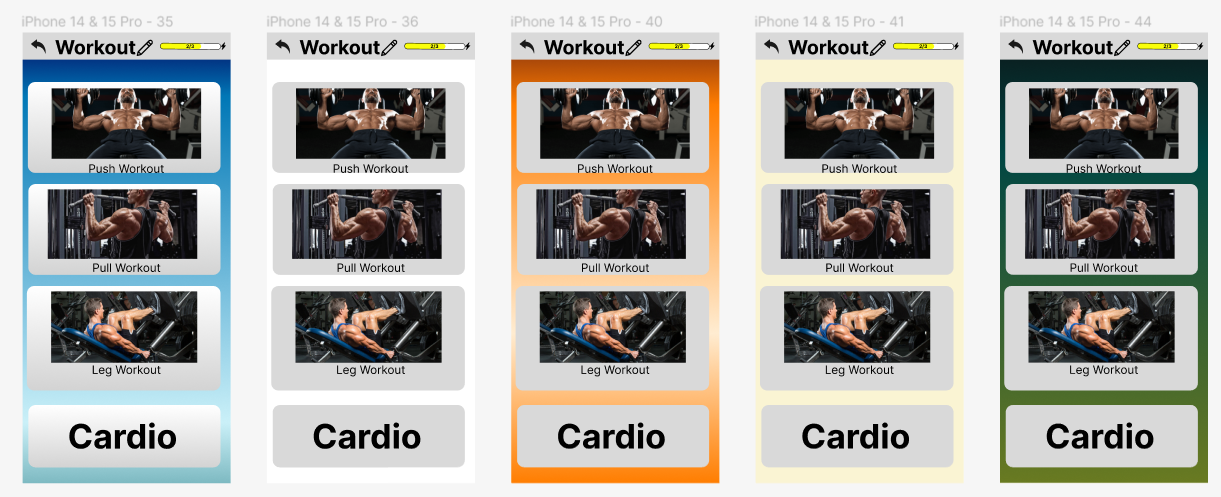
Balance: It must be balanced between effort paid/ time spent and the value of reward. It is frustrating to receive reward not valuable enough constantly. On the other hand, the players will no longer appreciate high value rewards if they are gained relatively easy.
The uncertainty itself of reward creates some fun. However, it is not suitable for rewards which are supposed to be tightly correlated to skills like score. In addition, for resources which are critical in clearing a stage in real-time like ammunition and life count, players prefer them to be expectable. Secrecy like hidden treasure and quest encourage players to dig into the game and be a contributor in the game society or to join online discussion and search for information.
Accumulated rewards, especially those not spent in game like experience points and virtual equipment, mark the progress of players and/or avatars and are suitable for comparison. So, this kind of reward is better in creating long- term and social sense of achievement. Instant feedback, on the other hand, makes a game responsive and “juicy”. This kind of reward helps maintain attractiveness and provide elements for flow experience.
Recommendations for reward systems:
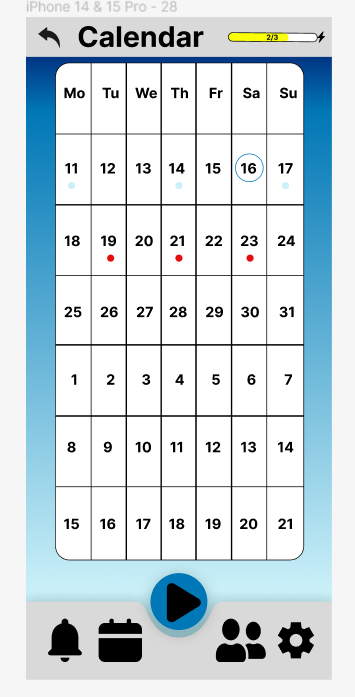
Personal level:
- Have the opportunity to receive extra points if you do more challenging tasks or if you go above and beyond your goals
- The rewards should have an element of surprise
- Get a trophy once you have completed 5 or 10 levels.
- Personal milestone points. If you set yourself a milestone and you complete it you get extra points.
- Consistency streak
- Recruitment bonus. If you get a friend involved in the app you get extra points.
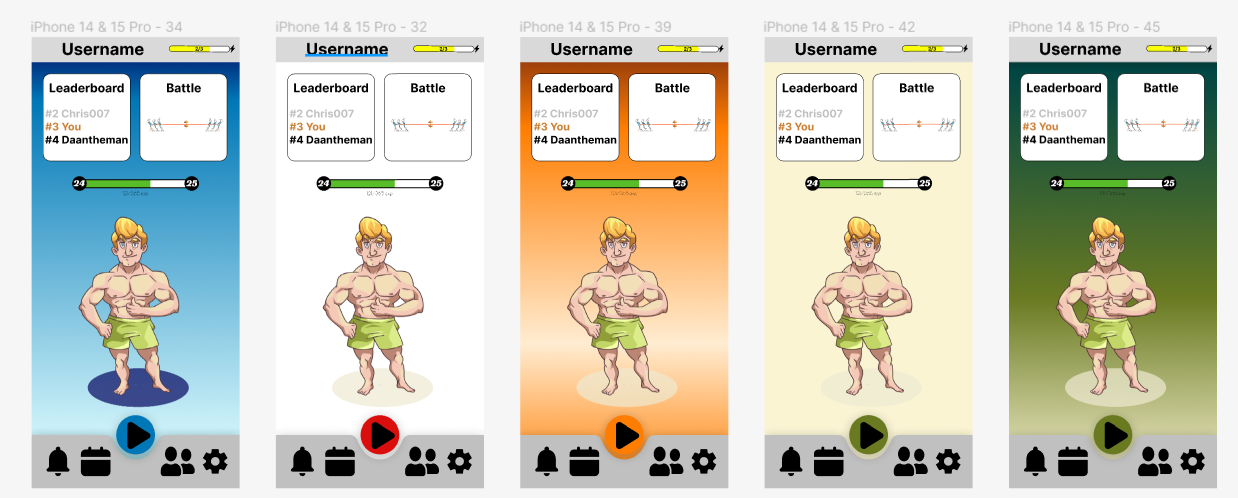
Collaborative
- Group challenges: were you get extra points for completing it perfectly or on time.
- Have a shared rewards pool in which you have to workout on your own, but there will be points added to your team's rewards pool and the team with the most points wins.
- Maybe something like the crazy 88, for which you have multiple days or a week to complete all the challenges or everyday you need to complete like a small task that will improve your health, but also holds you accountable for working together as a team.
- If you are on the leaderboard for a consecutive amount of days / time then you get extra points.
Informed consent form:You have been asked to participate in a focus group for the course Project robots everywhere: designing research of Eindhoven University of Technology. This document gives you information about this focus group and your rights as a participant. Please read it carefully.
About the focus group
The aim of this focus group is to get feedback about our motivational fitness app called Shape Shifters. The focus group will last approximately 60 minutes. We will start with a presentation about what the app is about. Then we will ask questions about the app. Durin the interview, we will make notes according to your answers. It will also be recorded in order to finalize the notes afterwards.
Voluntary
Your participation is completely voluntary. You can refuse to answer certain questions without giving any reasons and you can stop at any time during the focus group.
Confidentiality
Audio recording would be made during the focus group. We will not be sharing personal information about you to anyone outside of the research group. The information that we collect from this focus group is used for writing a report and presentation and will only be reported at a group level.
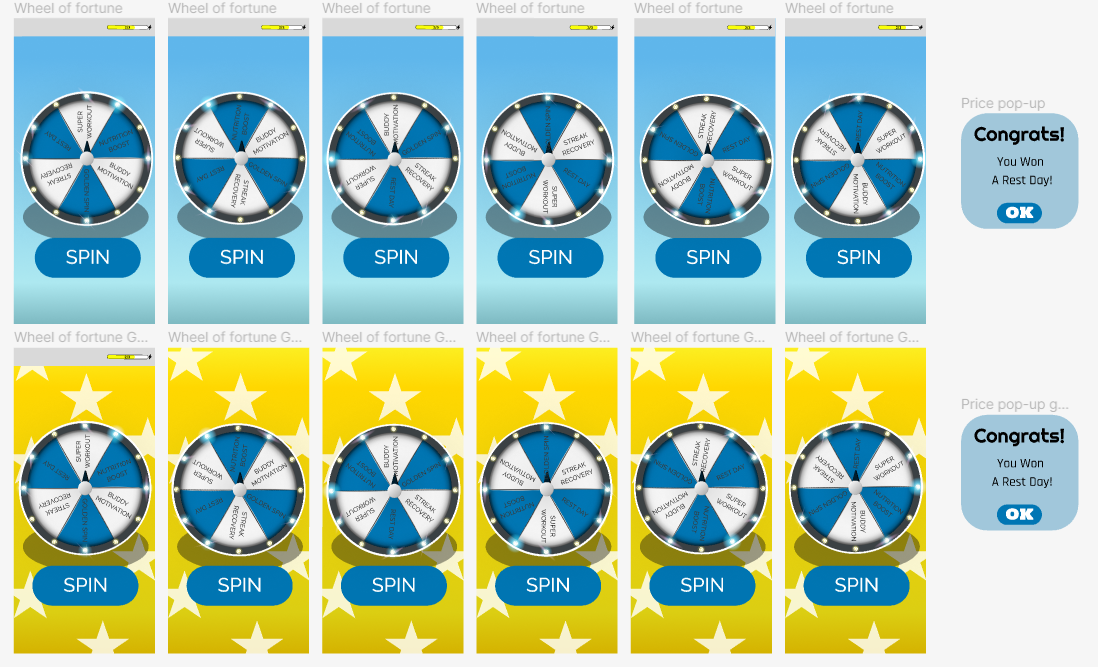
Further information
If you want more information about this interview, you can ask 0LAUK0 group 8. If you have any complaints about this study, please contact one of our supervisors, dr.ir. L.M.M. Royakkers (l.m.m.royakkers@tue.nl) or dr.ir. Raymond Cuijpers (r.h.cuijpers@tue.nl).
Certificate of Consent
I, (NAME)……………………………………….. have read and understood this consent form and have been given the opportunity to ask questions. I agree to voluntarily participate in this interview carried out by 0LAUK0 group 8 of the Eindhoven University of Technology.
Participant’s Signature Date
Prizes on the wheels of fortune:
SUPER WORKOUT: Next workout double XP 2x
NUTRITION BOOST: Character gains extra XP
BUDDY MOTIVATION: Gain extra XP when going with a friend
GOLDEN SPIN: Spin the golden wheel
STREAK RECOVERY: Gain a streak recovery, usable when streak is gone
REST DAY: Character gains extra XP for taking a resting day
Content week 5:
Chris SSA week 5:
From the focus group it was mentioned that people would like a timer to use during their workouts. Therefore Chris created a timer:
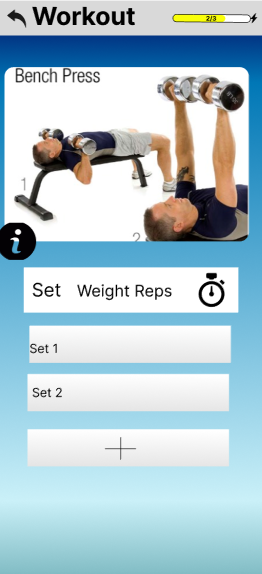
Daan SSA week 5:
Rewards for spinning wheel:
SUPER WORKOUT: Your character earns double XP by completing a bonus workout session, leading to a significant boost in experience points.
NUTRITION BOOST: Your character wins a package of nutritious snacks and supplements, enhancing their overall fitness and providing a small XP boost for their next 3 gym sessions.
BUDDY MOTIVATION: Your character receives motivational support from a gym buddy, inspiring them to push harder during their next workout and earning them bonus XP for their next gym session together.
GOOD GUIDANCE: Your character receives personalized training advice from a virtual personal trainer, resulting in improved technique and increased XP gains for the next workout.
VIP GYM ACCESS: Your character gains access to an exclusive VIP section of the gym, complete with premium equipment and amenities, motivating them to return for their next workout and earn extra XP.
WELLNESS RETREAT PACKAGE: Your character wins a package to attend a wellness retreat focused on rejuvenation and self-care. This opportunity to relax and recharge in a serene environment inspires your character to prioritize their health and well-being, motivating them to return to the gym feeling refreshed and ready to tackle their next workout with renewed enthusiasm, resulting in enhanced XP gains as they continue to progress on their fitness journey.
Gouden radje
Voor het gouden radje dacht ik dat verdubbelaars (als 2x, 3x, 4x XP) voor de volgende workout / boost die daarbij hoorde, de beste optie zou zijn. Hierdoor hoeven we geen 6 extra nieuwe boosts te verzinnen en geeft het toch een extra wineffect.
Chat screen for friends
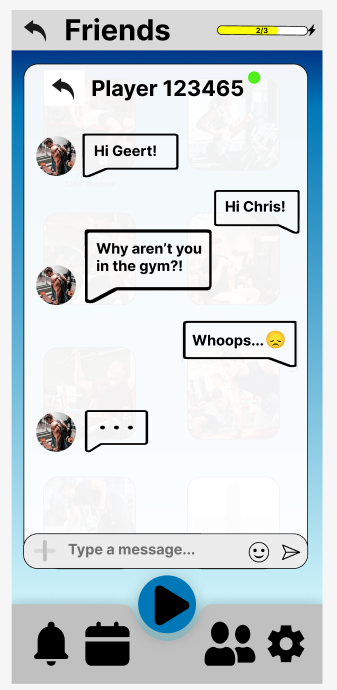
For the chat screen with friends I created the following (see below). I thought it would be most useful if you could get to the screen from the friends screen by clicking on a friend, or by looking at your notifications and clicking on that.
An extra idea, when you click on friends menu,multiple opties will appear like:
- Chat
- Profile
- Delete
- (Maybe more??)
Furthermore, he also worked on creating multiple colors for the app. There is a variety of blue, yellow, orange, and green available. So, that players can choose the color of the app.
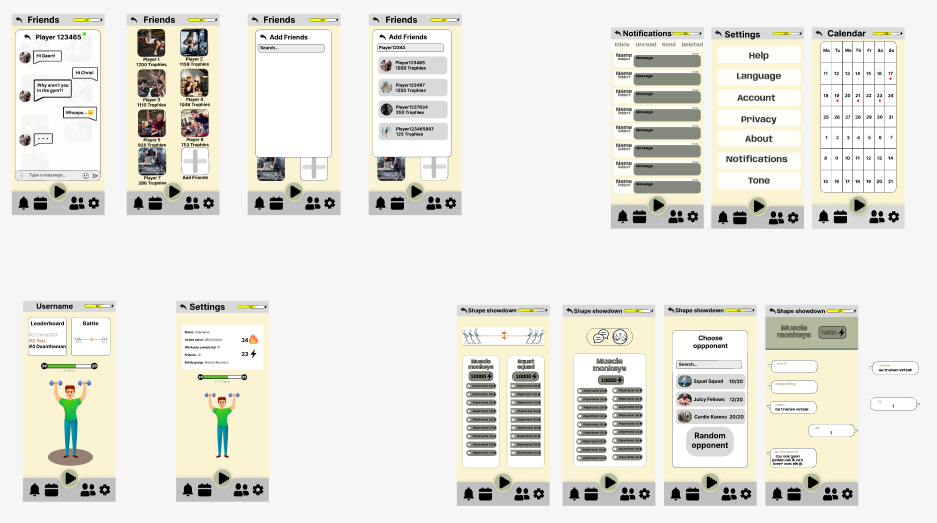
Geert SSA week 5:
Geert wrote down all the most important screens that still needed to be added after the feedback from the focus group.
He also worked on fine tuning the calender screen.
Roel SSA week 5:
Roel worked on a chat screen within the competition.

He also worked on screens that showecased how much XP was given for each exercise or completed program.
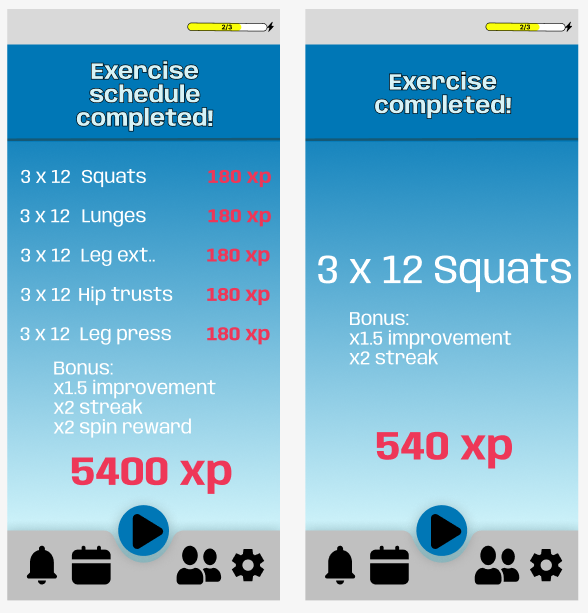
Finally, instead of only giving a writen description of how the exercise is to be done. Roel worked on gathering videos and or GIF's of how an exercise should be done
Thijn SSA week 5:
Thijn worked on character changes, because in the focus group multiple people mentioned that they did not resonate with the buff character that was displayed.

Furthermore, he also worked on the cardio screen because it was quite bare and lacked other essential forms of cardio besides running.
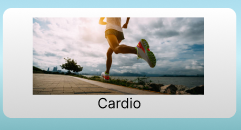
Louise SSA week 5:
Beginner workout information:
Day 1: Full Body Strength Training
1. Warm-up:
5 minutes of light cardio (e.g., brisk walking, jogging in place) OR
Dynamic stretches (arm circles, leg swings, etc.) for 5-10 minutes
2. Strength Training:
Bodyweight Squats: 3 sets of 10-12 reps
- It is important not to round your back and think about squeezing your butt when you go up. Mind muscle connection is really important.
- Keep your knees to the outside DO NOT collapse inward with your knees
- If you feel confident in the movement, add a light weight
Push-ups (on knees if needed): 3 sets of 8-10 reps
Dumbbell Rows (or Bent-over Rows): 3 sets of 10-12 reps per arm
- It is important to have a flat back and DO NOT round your back.
- When you are at the top of the movement squeeze your shoulder blades together and slowly lower down.
Plank: 3 sets, hold for 30-60 seconds each
- DO NOT raise your butt in the air. You want to be one line.
- In order to tense your core, go into downwards dog. Inhale at the top and exhale lower down while you squeeze your core together and try to hold this position.
Bodyweight Lunges: 2 sets of 10 reps per leg
- Try to make a 90-degree angle with your front leg. It is important that you DO NOT cross your toes with your knee. So, try to be at a 90-degree angle.
3. Cool Down:
Stretch major muscle groups (quads, hamstrings, chest, back) for 10 minutes
Day 2: Core and Upper Body Strength
1. Warm-up:
- 5-10 minutes of light cardio (jumping jacks, marching in place, etc.)
2. Core Workout:
Plank: 3 sets, hold for 30-60 seconds each
- DO NOT raise your butt in the air. You want to be one line.
- In order to tense your core, go into downwards dog. Inhale at the top and exhale lower down while you squeeze your core together and try to hold this position.
Russian Twists: 3 sets of 15-20 reps per side
- Move slowly side to side, while having tension on your core. DO NOT round your back
Bicycle Crunches: 3 sets of 15-20 reps per side
- Try not to pull on your head. This will cause neck pain. Instead have your hands behind your head as support.
- Try to do the movement slow and controlled.
Cat and cow: 3 sets of 10-12 reps
- Breath in and when you exhale round you back and suck as much air out as possible. Pull your stomach all the way in and hold for several seconds and breath in and bring your spine to a neutral position.
Plank with Shoulder Taps: 3 sets, 10-12 taps per side
- Try to keep your core steady and slowly tap your shoulders. It is easier when you move your legs in a wider stance.
3. Upper Body Strength Training:
Push-ups (on knees if needed): 3 sets of 8-10 reps
Dumbbell Shoulder Press: 3 sets of 10-12 reps
- Try not to go to heavy and have a controlled range of motion.
- It is important to keep your arms at a 90-degree angle and move them up and slowly lower them down in the same angle.
Bent-over Dumbbell Rows: 3 sets of 10-12 reps per arm
- It is important to have a flat back and DO NOT round your back.
- When you are at the top of the movement squeeze your shoulder blades together and slowly lower down.
Dumbbell Bicep Curls: 3 sets of 10-12 reps
- Try to keep your elbows in the same position and focus on the movement. Slowly lower down and go up a little bit faster.
Tricep Dips (using a chair or bench): 3 sets of 8-10 reps
4. Cool Down:
- Stretch upper body muscles (chest, shoulders, arms) for 10-15 minutes
Day 3: Flexibility and Recovery
- On the 3rd of this plan, recovery is highlighted. It is important to take your rest days, to ensure that you are fully recovered. Especially when you are a beginner, your muscles will not be used to the new movements you are making and in order to prevent injury it is important to take a rest day and ALWAYS listen to your body.
Below you can find several things to do if you still feel like you want to have an active rest day:
1. Warm-up:
5 minutes of light cardio (jumping jacks, jogging in place)
Dynamic stretches for full body mobility (arm circles, leg swings, etc.) for 10-15 minutes
2. Flexibility Training:
Yoga or Pilates routine focusing on flexibility and mobility
Hold each stretch for 15-30 seconds, repeating 2-3 times
3. Relaxation Techniques:
Practice deep breathing exercises or meditation for 10-15 minutes
4. Active Recovery:
Light walking or gentle swimming for 20-30 minutes
Remember to listen to your body and adjust the intensity or exercises as needed. It's essential to progress gradually and maintain proper form to prevent injuries. Also, stay hydrated throughout your workouts and refuel with a balanced diet rich in protein, carbohydrates, and healthy fats.
Introduction
Nowadays technological innovations have penetrated nearly every aspect of our lives, the realm of fitness remains a pivotal area that is broadened every year. With new research done and the variety of different exercise forms there is a ton of information on this subject. In the app store there are over 97,000 fitness and health apps providing all kinds of information. This can be viewed as overwhelming. How are we supposed to know which app to choose? And will this app live up to my expectations? Or will I be bored after using it for a week? This overload of information can cause a barrier for the population, because we simply do not know what to do with all the information provided. Not only the overwhelming amount of information is a barrier to work out, also the lack of motivation seems to be a contributing factor to the lack of physical activity among young adults. This lifestyle among young adults not only contributes to a variety of health issues, but also impacts their overall productivity and quality of life.
Despite the awareness regarding the benefits of physical activity, a substantial portion of the young adults remain disengaged from fitness activities. Furthermore, not only the lack of motivation can be discouraging, but also for beginners, the gym environment can seem like a daunting place where you feel judged by everyone around you. This intimidation factor, coupled with the absence of motivation towards fitness, often leaves individuals feeling overwhelmed and even less motivated.
As we recognized these challenges as a call to action, this project aims to motivate the young adults who want to work out but are still reluctant to go to the gym. This is done by the fusion of fitness and gamification. Our mission is twofold: to address the issue of lack of physical activity amongst the youth and to inspire and empower individuals who have yet to embark on their fitness journey.
The decision to focus our efforts on developing a gamified fitness app is because games are considered to be fun and engaging. So, by using the principles of game design and applying them to fitness activities, the project aims to put a twist on the way individuals perceive and engage with exercise. Through interactive challenges, rewards systems, and immersive experiences, the app seeks to diffuse the fitness journey with elements of excitement, competition, and achievement, in order to create a fun and engaging app.
Furthermore, the choice to target young adults as a demographic specifically is rooted in not only the convenience of having similar aged people as a demographic, but also because young adults are in their prime years to shape future health behaviours (SOURCE). By forming positive exercise habits early on, we not only will prevent the health risks that will come with a lazy lifestyle, but also lays a foundation for a lifetime of well-being and vitality.
Moreover, the commitment to inclusivity and accessibility underscores the dedication to reaching individuals who may feel excluded from traditional fitness spaces by for example the overwhelming amount of information or the intimidation of the fitness community as mentioned above. By providing a digital platform that helps diverse fitness levels, preferences, and schedules, the app strives to create a welcoming and supportive community where every individual feels empowered to embark on their fitness journey at their own pace.
Theorie
There are several ways to tackle the problem of designing a gamified fitness app, but before this is done. A literary review needs to be done into motivation and GUI.
Motivation is a vital element for success in any area of life. Motivation helps use stay engaged longer, reach our goals, and this will lead to a feeling of accomplishment. Motivation is also the backbone of success in gamified fitness apps. These apps strategically incorporate various motivational strategies to inspire players to not only start doing physical activity, but also stay true to their fitness goals.
Before continuing, gender differences in motivational factors must be considered. While males are often more motivated by intrinsic factors such as strength, competition, and challenges. Females may be more driven by extrinsic factors like weight management and appearance. By tailoring motivational strategies to individual preferences and needs gamified fitness apps van effectively engage a diverse user base.
Now let's discuss one crucial aspect of gamified fitness apps, providing players with decision points and improvement narratives. This helps with the fostering of autonomy and a sense of accomplishment. By allowing players to choose their progression paths and customize their experiences, these apps empower individuals to take ownership of their fitness journey. Improvement narratives, such as character progression and item collection, offer tangible goals for players to strive towards, further enhancing motivation. (Source)
Furthermore, multiplayer engagement plays a role in motivating players, by integrating cooperative and competitive elements. Cooperative challenges create a sense of community and support, while competitive features appeal to players driven by challenges and achievements. Additionaly, multiplayer engagement features, like playing in a team, foster social interactions and friendly competition. Team sport activities are intrinsically motivating to players through positive social interaction and play. Players are therefore more likely to continue exercising compared to activities that rely solely on extrinsic motivation such as the expectation of improved health and well-being. (source) A study done by (source) also touches on this subject and argues that “health-promoting actions which are extrinsically motivated may be less likely to be repeated than actions pursued due to genuine personal interests”. App developers must therefore promote behaviours in a way that encourages people to internalize the need and desire to change.
Moreover, the tone and frequency of notifications is also an important consideration. Meaning that messages should be uplifting and positive, promoting a supportive environment. Personalization in notifications based on personality and/or gender enhances the effectiveness of the motivational messages, ensuring they resonate with players and inspire action. Furthermore, delivering timely and relevant messages to players will serve to remind, encourage, and motivate them to engage in physical activity. Notifications can therefore be used to reinforce positive behaviours, such as consistent exercise. Consistency in exercise followed by a reward, has also been shown to have a link to motivation. They reinforce the habit-forming nature of exercise by rewarding players if they workout consistently. The receiving of the reward or having a streak will motivate the players to go exercise on a regular basis. However, punishment should be used carefully, as it can demotivate players. Instead, there should be a focus on positive reinforcement to maintain engagement and motivation. Furthermore, a reward feels the most fulfilling when it is received after finishing a really difficult level. So, setting appropriate difficulty levels is a fundamental to sustaining player's motivation. In order to keep a player engaged, the task should be challenging yet attainable in order to prevent discouragement. However, when the challenge is too easily completed the player can also feel like the reward is not deserved and will not feel as accomplished as when receiving a reward after completing a difficult task. On top of that, implementation of motivation in gamified fitness apps can incorporate dynamic progression systems based on user preferences and exercise history. Random reward timing will stimulate dopamine release and will enhance motivation (source). Study shows that, randomly and intermitted reward timing (RIRT) is an effective tool for dopamine release. The key in RIRT is to celebrate the wins, but do not celebrate every win. Meaning that rewards are fun, but they are most effective to motivation if they are received when the player least expects it, ensuring that they are engaged in the app and motivated over a long period.
As mentioned above, sustaining motivation requires more than just initial enthusiasm, it needs ongoing support and reinforcement. By integrating these motivational elements, gamified fitness apps create an environment aimed at sustaining engagement and progress towards fitness goals. As such, understanding the power of motivation is essential in the design and optimization of these applications, ensuring their effectiveness in inspiring and empowering users on their fitness journey.
Now that we have discussed the motivational elements needed in gamified fitness apps. Let's look at the GUI. The primary goal of a GUI is to allow the user to concentrate on the task at hand. The GUI must therefore make the interface between the human and app smooth. Humans have limited memory, so it is better to group information using the Gestalt principle, which means humans have a short-term memory span of around 7 items. A good GUI should present information that is contextual and consistent. It should avoid unnecessary detail and put as much information in as less words as possible to conserve screen space. It is better to utilize familiar data formats, if they exist. Furthermore, a GUI should use colours to group information. Graphical boundaries are very effective in grouping items. Other highlighting techniques are reverse video, brightness, underlining and flashing. The information should be presented in a sequence which the user needs it in. More important information should precede the lesser important information and general items should precede more specific items. Frequently used, needed information or commands should be in the most important location. If there is no order, use alphabetical order. A bad GUI prevents the user from concentrating on its task. When designing a GUI, keep the objective in mind and avoid needless complexity.
Furthermore, the colours used in an app should not be more than 3, it should be as simplistic as possible. Different colors generate specific human behavior. Social media apps usually use mostly bright and vibrant colors, while mind and body apps usually use more neutral colors. Here are some words with associated colors:
- Security and trust: Blue
- Speed: Red
- Cheapness: Orange and yellow
- High quality: Black (orange the least)
- High technology: Black, blue and gray
- Reliability: Blue
- Fun: Orange and yellow
You have to think about the impression that you want to give the users. If you want to give the expression it is an entertaining app, then use warm tones, but if you want to show it is a trade or e-commerce app, then use cooler tones like blue or a gray-scaled scheme, which is more reliable.
The study of GUI is important in keeping the engagement of the player, while also ensuring that they enjoy the game. A bad GUI sabotages all the hard work done on the app, and it is therefore important to have the GUI before the development of the app begins.
State-of-the-art
There are two areas that you need to be looked into. First of all, research needs to be done into to the already existing fitness apps and what they contribute into motivating people. Secondly, we need to do research into how gamification is already used in fitness apps. First, let's look into the most used fitness apps that are currently on the market. There are many fitness apps currently on the market, but a few distinctions can be made. First of all, there are the fitness apps that are free like Nike training club, FitOn, and Adidas training and there are those that require paid subscription like muscle booster, peloton, fitbot, and Aaptiv. Furthermore, the apps mentioned above all make use of either video or audio to explain the exercises. Some even have complete follow-along workouts in which you train with a personal trainer. Lastly, the current fitness apps make use of a filtering system, by which you can filter based on either difficulty, time, and/or type of workout. Now let's delve into the already existing gamification in fitness apps. (Source) made a distinction between 5 different fitness apps that already use gamification, PlayFitt, Hops, Treeceps, Nerd fitness journey, and Fitness RPG. Looking at the details of the gamified apps we see that there are several apps that use a leaderboard in which you are compared to other players (Fitness RPG and PlayFitt), others make use of daily trackers to stimulate the forming of habits (PlayFitt, Hops, Nerd fitness journey, and Fitness RPG) and some give you the opportunity to customize the character (PlayFitt and Hops).
Method
A survey was sent out to a randomly selected group of students or other people ranging from the ages of 16 to 25. Within 5 days we had received 113 valid responses. This survey was created based on the knowledge needed to design our app. The survey was divided into 3 different categories. The first category was about gender, age, and other technicalities. The second category was about whether the participants already worked out and if so, how often. The third and final category was about preferences for the app, like what colour would you prefer, what tone of notifications has your preference, etc. The answers of the survey contained mostly fixed responses. These were analysed by the google forms function and put into an excel sheet.
Thereafter, a focus group was set up with a select group of students. Some of which worked out regularly and others who had never worked out before. The focus group was split into two sessions each consisting of 5 students, in order to get a more diverse argumentation and also to see whether there were any similarities or differences between the two sessions.
Finally, a last survey was sent out....
Results
The results from the first survey were as follows:
number of survey participants: 113
Personal identification
39.8% female, 57.5% male, 2.7% other
Average age is 19.76, ranging from 17 to 24
94.7% is a Student
Current exercise situation
Average frequency of exercise is about 3 times a week (When considering “more than 5” as 6.5)
About 70% (69.9%) would like to exercise more
2/3 of all participants would like to do strength training, 44.1% would like to do Hypertrophy and 68,5% would like to do cardiovascular training.
61.9% is interested in using an app for exercise motivation
64.2% does not currently use a tracking/fitness app
App shape
Option 1(lightblue and gray) is the most popular (55.8%), others don’t get higher than 22.1%. Around 10% is displeased with all concepts.
Preferred tones are Funny (56.8%) and Considering (43.2%)
Multiplayer
Competing against other people is endorsed by 73.5%
Of those who want multiplayer:
94,4% would like to compete against friends
80,6% would like to compete against others
(note that the amount of people that replied varies, with n=90 and n=93 respectively, this is also not representative with the original 73.5%, showing that on average about 9 people answered against multiplayer, but still gave feedback on its creation)
Push notifications
About 70% (69.6%) would like to receive motivational push notifications
Only 38,4% would like to receive notifications about in game events or other-player progression.
Program creation
78,4% would like to make their own exercise program
88,4% would like to receive a program, based on their goals
On a scale from 1 to 5, the preferred customizability is 3.7 (2.7 if 0 to 4)
Tracking in between exercises is possible for 85.7%
On a scale from 1 to 5, the willingness to have predetermined exercise times is 2.25 (1.25 if 0 to 4)
The progression systems are ranked as follows:
- Character level up (53.2%)
- “wins” over other players (43.2%)
- Gaining currency/Exp (36.9%)
- Power levels (32.4%)
- Character gathering and leveling (29.7%)
The character creation systems are ranked as follows:
- Humans (57.7%)
- Animals (40.5%)
- Fantasy creatures (31.5%)
- Hybrids (15.3%)
The results of the first questionnaire helped with designing a rough sketch of the app.
(SHOW THE SKETCHES)
After the sketches were discussed, an app was developed with keeping in mind the preferences of the surveys and our own preferences. The following screens were developed:
(The feedback from the focus group)
(The changes made)
I also looked into the TAM model and found a very convincing article, that also looks at gamified fitness apps and how the TAM model is used in the behavior change of the users.
Furthermore, I looked at my minutes of the focus group and made a list of the most notable comments by the people:
- For the color we must have either blue or an option to choose from different colors yourself.
- The figure must show progression and different figures must be available for what different people want.
- Cardio and the calendar need to be further developed
- The competition element is very popular with people. So this should be worked out better so that it is perfect. For example, the report must provide an explanation as to why people indicate this preference.
- Most people who have the app will probably be beginners. So there needs to be a standard plan that they can follow.
- The best way to score points is to get points when you have completed an exercise set and when you have completed the entire program you should get extra/bonus points or should we not do that and keep the wheel?
- Personal goals that you can define yourself would be a nice addition.
- A timer for during the workout to track breaks
- Preferably no messages during the workout, but preferably just a notification once a week that you still have to exercise.
- Consistency is very important. So if you have achieved your goal you get points and if you have made progress you get extra points.
- Send messages to friends
- If possible, it is nice to implement videos of the exercise for extra clarity.
- What you did in the previous set of the exercise should already be noted down.
Planning:
| Monday
5 February |
Tuesday
6 February |
Wednesday
7 February |
Thursday
8 February |
Friday
9 February |
Saturday
10 February |
Sunday
11 February |
| Lecture & meeting | Send E-mail & meeting | |||||
| Monday
12 February |
Tuesday
13 February |
Wednesday
14 February |
Thursday
15 February |
Friday
16 February |
Saturday
17 February |
Sunday
18 February |
| Vacation | Vacation | Vacation | Vacation | Vacation | Update Wiki | |
| Monday
19 February |
Tuesday
20 February |
Wednesday
21 February |
Thursday
22 February |
Friday
23 February |
Saturday
24 February |
Sunday
25 February |
| Meeting | Meeting | Finish the questionnaire | Update Wiki | |||
| Monday
26 February |
Tuesday
27 February |
Wednesday
28 February |
Thursday
29 February |
Friday
1 March |
Saturday
2 March |
Sunday
3 March |
| Meeting | Meeting | Update Wiki | ||||
| Monday
4 March |
Tuesday
5 March |
Wednesday
6 March |
Thursday
7 March |
Friday
8 March |
Saturday
9 March |
Sunday
10 March |
| Meeting | Meeting | Finish motivation & Gui research | Update Wiki | |||
| Monday
11 March |
Tuesday
12 March |
Wednesday
13 March |
Thursday
14 March |
Friday
15 March |
Saturday
16 March |
Sunday
17 March |
| Meeting | Meeting | Finish exercise program | Update Wiki | |||
| Monday
18 March |
Tuesday
19 March |
Wednesday
20 March |
Thursday
21 March |
Friday
22 March |
Saturday
23 March |
Sunday
24 March |
| Meeting | App is finished & start last questionnaire | Meeting | Update Wiki | |||
| Monday
25 March |
Tuesday
26 March |
Wednesday
27 March |
Thursday
28 March |
Friday
29 March |
Saturday
30 March |
Sunday
31 March |
| Meeting | Meeting | Finished with final report | Update Wiki | |||
| Monday
1 April |
Tuesday
2 April |
Wednesday
3 April |
Thursday
4 April |
Friday
5 April |
Saturday
6 April |
Sunday
7 April |
| Free | Final presentation |
Sources:
Literature found week 1:
Louise:
| Link: | Content: |
| https://link.springer.com/article/10.1007/s11218-011-9157-z | This article is mostly about motivation among students. It does not touch on exercise, but it does discuss that not only the goals of the students are important, but also whether the goals are reached. |
| https://journals.sagepub.com/doi/abs/10.1123/rsj.2017-0026 | This article is about motivation to exercise among students. It looks at extrinsic motivation to exercise. This could help with the development of our app because this would also be an extrinsic motivator. |
| https://www.amjhealthstudies.com/index.php/ajhs/article/view/57 | This article looked at the barriers that students face when wanting to exercise. |
| https://www.tandfonline.com/doi/full/10.1080/07448481.2010.513074 | In this article, they looked at how race, gender, and age affected motivation to exercise. |
| https://hubermanlab.com/newsletter/tools-to-manage-dopamine-and-improve-motivation-and-drive | This article looked more into the neuroscience side of motivation. It looks into how dopamine affects motivation. |
Roel:
| Link: | Content: |
| Full article: Leveling Up Your Game: The Use of Video Games as a Therapeutic Modality (tandfonline.com) | This article introduces and begins to explore the use of video game technology in a therapeutic setting, providing context, rationale, and an introduction to the culture of video game players. |
| The Gameful World: Approaches, Issues, Applications - Google Boeken | This article talks about the approach, issues and applications of creating a game-like world. |
| Health promotion: The impact of beliefs of health benefits, social relations and enjoyment on exercise continuation - Nielsen - 2014 - Scandinavian Journal of Medicine & Science in Sports - Wiley Online Library | This article explores how and why participants in structured exercise intervention programs continue or stop exercising after the program is finished |
| Health impact of sport and exercise in emerging adult men: a prospective study | Quality of Life Research (springer.com) | This article talks about the impact of sport and exercise on young men |
| Full article: Promoting habit formation (tandfonline.com) | This article talks about how to give developers the tools to help establish target behaviors as habits. |
| The Effects of Cooperation and Competition on Intrinsic Motivation and Performance. (apa.org) | This article investigates the effect of cooperation and competition on intrinsic motivation and performance, and the difference between the two effects. |
Daan:
| Link: | Content: |
| Thehowandwhyoffitnessappuseinvestigatingusermotivationstogaininsightsintothenexusoftechnologyandfitness.pdf | The article discusses fitness tracking apps and how they promote fitness activity. It further discusses motivation and provides potential improvements in terms of motivation for fitness apps. |
| Motivation and timing: Clues formodeling the reward system - ScienceDirect | This article discusses how our neurological reward system works and its connection with motivation. |
| CanMobileAppsMotivateFitnessTrackingAStudyofTechnologicalAffordancesandWorkoutBehaviors.pdf | The study investigated the impact of features in a workout app on exercise outcomes and goal attainment for 682 users, finding that elements promoting relatedness, autonomy, and competence positively predicted results. |
| Workout Motivation Through Technology-Mediated Training (jackyfwong.com) | Short article that discusses how technology could help with workout motivation and how it could improve workout outcomes. |
| Full article: Sport and fitness app uses: a review of humanities and social science perspectives (tandfonline.com) | This study looks at sociological interpretations addressing several factors and potential positive and negative effects of such apps. |
| Sports App User Behavior Analysis: Participation Motivation, Satisfaction, and Loyalty (hindawi.com) | Part of the article is about how sports app users are motivated and what effects this has. |
| MolinaandSundarChapterinHealthTheoryBook.pdf | A book that looks at how media can affect a person's health along with motivation. |
Chris:
| Link: | Content: |
| https://www.scopus.com/record/display.uri?eid=2-s2.0-85162186527&origin=resultslist&sort=plf-f&src=s&sid=0958581a1dcf5e74db849ef0873317bb&sot=b&sdt=b&s=TITLE-ABS-KEY%28%22mobile+exercise%22%29&sl=31&sessionSearchId=0958581a1dcf5e74db849ef0873317bb&relpos=1 | |
| https://www.scopus.com/record/display.uri?eid=2-s2.0-85168993626&origin=resultslist&sort=plf-f&src=s&sid=0958581a1dcf5e74db849ef0873317bb&sot=b&sdt=b&s=TITLE-ABS-KEY%28%22exercise+apps%22%29&sl=31&sessionSearchId=0958581a1dcf5e74db849ef0873317bb&relpos=16 | |
| https://www.tandfonline.com/doi/10.1080/10410236.2018.1536961 | |
| https://www.scopus.com/record/display.uri?eid=2-s2.0-85174183820&origin=resultslist&sort=plf-f&src=s&sid=0958581a1dcf5e74db849ef0873317bb&sot=b&sdt=b&s=TITLE-ABS-KEY%28%22exercise+application%22%29&sl=31&sessionSearchId=0958581a1dcf5e74db849ef0873317bb&relpos=8 | |
| https://mhealth.jmir.org/2016/2/e62 | This is an article that shows that usage of a tracking app greatly enhances the frequency of exercise. |
| https://journals.sagepub.com/doi/full/10.1177/1090198112452126 | This article shows research about the lack of a proper exercise app, mostly hinting at a lack of proper theory inclusion |
Thijn:
| Link: | Content: |
| Motivation in sport settings: A goal perspective approach. (apa.org)
|
The first link is the APA of the book from the second link. It is about a book which adopted a goal-focused approach to the study of motivation in sport. It focusses on three major issues, namely the relationship between goal perspectives and cognitive mediators of motivation, intrinsic interest and the correspondence between goal perspectives and the broader concept of values in the sport domain. |
| An integrative analysis of intrinsic and extrinsic motivation in sport (tandfonline.com) | The purpose of this paper is to propose a motivational sequence that integrates much of the intrinsic and extrinsic motivation literature in sport. |
| Motivation-in-sport-from-a-collective-efficacy-perspective.pdf (researchgate.net) | This article is about group motivation. So, it focusses on the motivation in team sports. |
| Toward a Developmental Theory of Children's Motivation in Sport in: Journal of Sport and Exercise Psychology Volume 9 Issue 2 (1987) (humankinetics.com) | This article is about motivation in sport for children. It mainly focusses on the achievement motivation. |
| Achievement motive and sport participation - ScienceDirect | The article is about three studies which investigated the relationship between the achievement motive and sport participation. It looks at implicit and explicit motivation. |
| College Students' Motivation for Physical Activity: Differentiating Men's and Women's Motives for Sport Participation and Exercise: Journal of American College Health: Vol 54, No 2 (tandfonline.com) | This article is about a study in which the authors compare motivations for sport participation versus exercise among college students. |
Geert:
| Link: | Content: |
| https://mhealth.jmir.org/2016/2/e39 | This article is about how effective mobile apps are when it comes to promoting a healthy lifestyle among adolescents and students. It is literature study combining 15 other studies. |
| https://mhealth.jmir.org/2019/7/e11926/ | This article analyzes 2000 apps in order to determine which one is most effective in causing a behavioral change. |
| https://www.researchgate.net/profile/Atreyi-Kankanhalli/publication/309557443_Gamification_in_Fitness_Apps_How_do_Leaderboards_influence_Exercise/links/586ca96f08ae8fce4919f096/Gamification-in-Fitness-Apps-How-do-Leaderboards-influence-Exercise.pdf | This study analyzes the gamification of fitness apps. And focuses specifically on whether a competitive leaderboard is boosting motivation. |
| https://www.sciencedirect.com/science/article/abs/pii/S1441352318302225 | This article compares a more social app where you can chat with each other to a gamified app which is oriented towards fun to motivate. As it turns out according to this social is more effective. |
| https://www.mdpi.com/2254-9625/13/8/103 | This article goes into the negative and positive effects of gamefication on the health and fitness industry. |
| https://journals.sagepub.com/doi/full/10.1177/0890117118790394?casa_token=gUEjY5q6tKMAAAAA%3A0tsZvqCuPEhC7PdCKiVxakcIeBEHxZs8hN2MpnnaKe9WiGclpEZWG2KQqt-P9ul-8Nc8-L1cdqM | This article analyzes different game aspects of gamification and analyzes each effectiveness. |
Week 2 literature:
GUI
https://dl.acm.org/doi/pdf/10.1145/279044.279051
Motivation
https://journals.sagepub.com/doi/full/10.1177/22786821211000182
https://link.springer.com/article/10.1007/s00779-017-1025-1
https://academic.oup.com/abm/article/56/2/212/6237428?login=false
https://link.springer.com/chapter/10.1007/978-3-319-10208-5_2
https://www.hubermanlab.com/newsletter/tools-to-manage-dopamine-and-improve-motivation-and-drive
https://psycnet.apa.org/record/2004-14304-005
https://europepmc.org/article/med/20046192
https://journals.sagepub.com/doi/abs/10.1123/rsj.2017-0026
https://link.springer.com/article/10.1007/s11218-011-9157-z
State-of-art
https://www.youtube.com/watch?v=irMJLcmSG5k
https://www.ncbi.nlm.nih.gov/pmc/articles/PMC7510592/
https://www.makeuseof.com/apps-gamify-fitness-routine/
https://shakuro.com/blog/fitness-app-gamification-in-2021-a-trend-you-cant-miss
https://link.springer.com/chapter/10.1007/978-3-031-24294-6_24
McKay, F. H., Wright, A., Shill, J., Stephens, H., & Uccellini, M. (2019). Using Health and Well-Being Apps for Behavior Change: A Systematic search and Rating of apps. Jmir Mhealth and Uhealth, 7(7), e11926. https://doi.org/10.2196/119264
Edwards, E., Lumsden, J., Rivas, C., Steed, L., Edwards, L., Thiyagarajan, A., Sohanpal, R., Caton, H., Griffiths, C., Munafò, M. R., Taylor, S. J. C., & Walton, R. (2016). Gamification for health promotion: systematic review of behaviour change techniques in smartphone apps. BMJ Open, 6(10), e012447. https://doi.org/10.1136/bmjopen-2016-012447
Cowan, L., Van Wagenen, S. A., Brown, B. A., Hedin, R. J., Seino-Stephan, Y., Hall, P. C., & West, J. H. (2012). Apps of Steel: Are exercise apps providing consumers with realistic expectations? Health Education & Behavior, 40(2), 133–139. https://doi.org/10.1177/1090198112452126
Questionnaire
https://forms.gle/ZRBihpS5EVGqeqFLA
App development
https://youtu.be/va3Gbtb1S0E?si=kcwj4b2MfTN-ghSu
https://mycolor.space/?hex=%235E9CC2&sub=1
Log:
| Week 1 | Total hours | Tasks done (incl. hours per task) |
| Geert Boer | 7h | Lecture and meeting (3.5h), finding literature (1h), second meeting (1.5h), app research (1h) |
| Roel Domensino | 7h | Lecture and meeting (3.5h), finding literature (1h), second meeting (1.5h), research (1h) |
| Daan Kuijpers | 7h | Lecture and meeting (3.5h), finding literature (1h), second meeting (1.5h), exploring Figma (1h) |
| Louise Rietra | 7h | Lecture and meeting (3.5h), finding literature (1h), second meeting (1.5h), motivation (1h) |
| Chris Smeets | 7.5h | Lecture and meeting (3.5h) finding literature (1.5h), second meeting (1.5h), research workouts (1h) |
| Thijn van Veggel | 8h | Lecture and meeting (3.5h), finding literature (1.5h), second meeting (1.5h), GUI research (1.5h) |
| Week 2 | Total hours | Tasks done (incl. hours per task) |
| Geert Boer | 6.5h | Meetings (4h), state-of-the-art (2.5h) |
| Roel Domensino | 8.5h | Meetings (4h), research and conclusions motivation (2,5h),comprehensive report motivation (2h) |
| Daan Kuijpers | 9h | Meetings (4h), App development (4.5h), Uploading Wikipage (0.5h) |
| Louise Rietra | 6h | Meetings (4h), state-of-the-art (2h) |
| Chris Smeets | 7.5h | Meetings (4h), Character concept (1h), Data gathering and analysis (2.5) |
| Thijn van Veggel | 6h | Meetings (4h), App development and looking at example apps (2h) |
| Week 3 | Total hours | Tasks done (incl. hours per task) |
| Geert Boer | 10.5h | meetings (4h) , Design ideas app + Charachter concept(3h), designing the friend page and add friend page in figma (3,5h). |
| Roel Domensino | 8h | Meetings(4h),sketches/ideas app pages(1.5h), detailed competition page (2h), Uploading Wikipage (0.5h) |
| Daan Kuijpers | 10h | Meetings (4h), Design ideas app + Character concept (3h), Designing app further (3h) |
| Louise Rietra | 10h | meetings (4h), design ideas app + Character concept (3h), figuring out Figma and designing the settings and notification page (3h) |
| Chris Smeets | 10.5h | meetings (4h), Design ideas app + Character concept (3h), Designing pages surrounding exercise (3.5h) |
| Thijn van Veggel | 10h | meetings (4h), Design ideas app + Character concept (3h), designing the homepage (3h) |
| Week 4 | Total hours | Tasks done (incl. hours per task) |
| Geert Boer | 7.5h | Lecture and meeting (4h), giving all screens the same theme and background (1.5h), second meeting (1.5h), creating the calendar screen (0.5h) |
| Roel Domensino | 9 | Lecture and meeting (4h), Change competition and change log in screen (1.5h), second meeting (1.5h), presentation focus group (2h) |
| Daan Kuijpers | 5h | Lecture and meeting (4h), Make fortune wheel work (1h) |
| Louise Rietra | 9h | Lecture and meeting (4h), reward system (1.5h), second meeting (1.5h), writing motivation, results, and GUI for report (2h) |
| Chris Smeets | 9h | Lecture and meeting (4h), elaborate the workout screen (1.5h), second meeting (1.5h), linking all the screens together (2h) |
| Thijn van Veggel | 7h | Lecture and meeting (4h), working on the app (2.5h), second meeting (1.5h) making informed consent form (0.5h) |
| Week 5 | Total hours | Tasks done (incl. hours per task) |
| Geert Boer | 7h | Lecture meeting, and focus group (4h), plan screens (0.5h), second meeting (1.5h), calender (1h) |
| Roel Domensino | 7h | Lecture, meeting, and focus group (4h), competition chat screen (1h), reward screens and videos for exercises (2h) |
| Daan Kuijpers | 6.5h | Meeting (2h), Rewards wheel adjusted (0.5h), Working on app (4h) |
| Louise Rietra | 10.5h | Lecture, meeting, and focus group (4h), TAM research, introduction, continuing report, and summarize the main points focus group (2.5h), second meeting (1.5h), screens for beginner and setting personal goals (1h), cleaning and adjusting wiki (1.5h) |
| Chris Smeets | 6h | Lecture, meeting, and focus group (4h), Incorporating timer (0.5h), second meeting (1.5h) |
| Thijn van Veggel | 8.5h | Meetings (4h), Focus group preparation and execution (3h), Working on Figma (1.5h) |